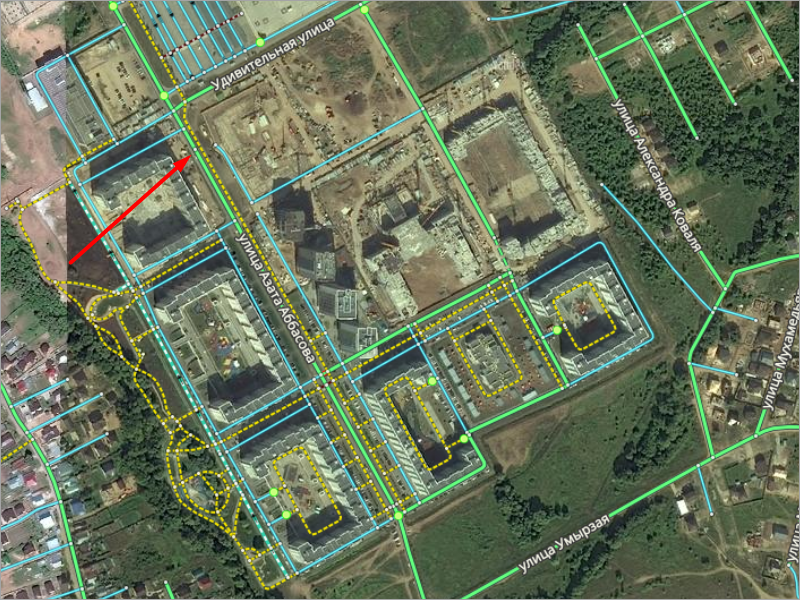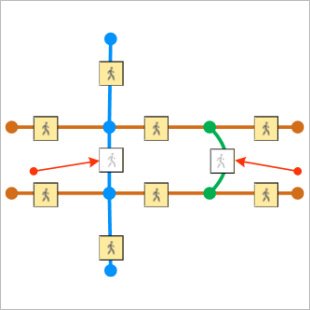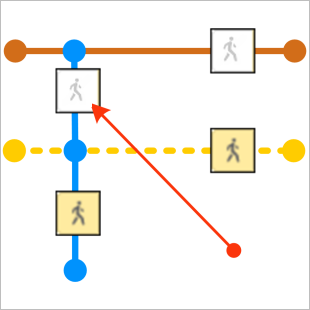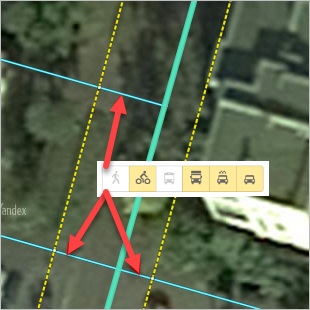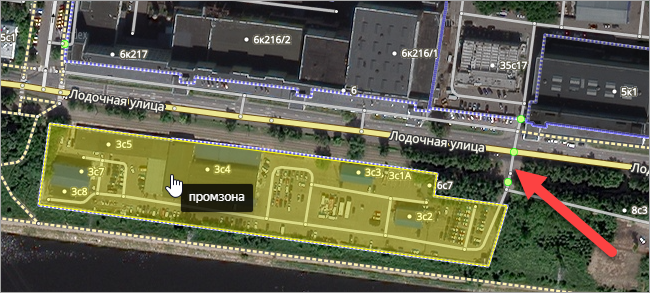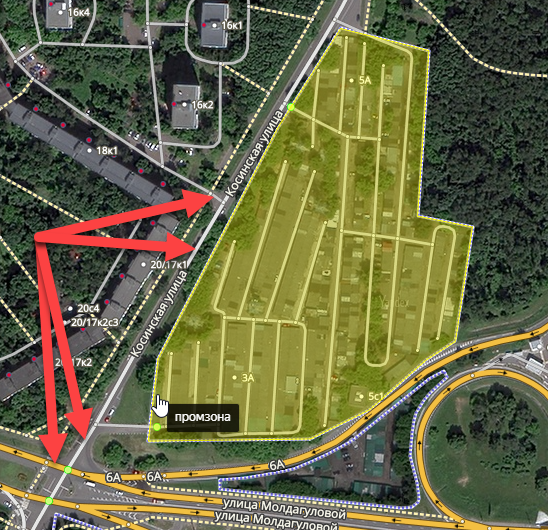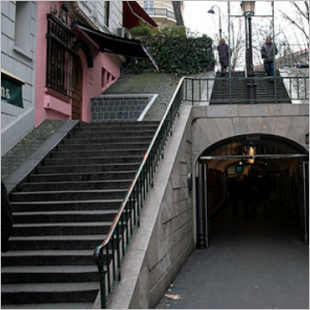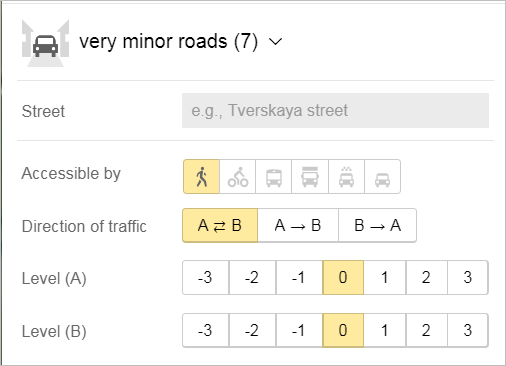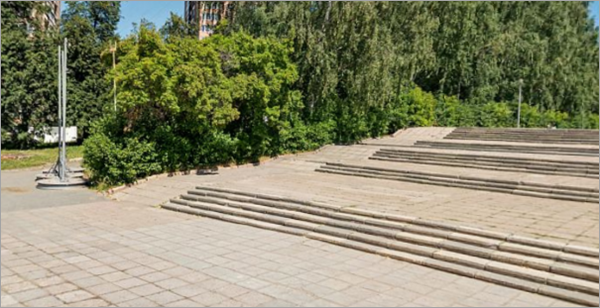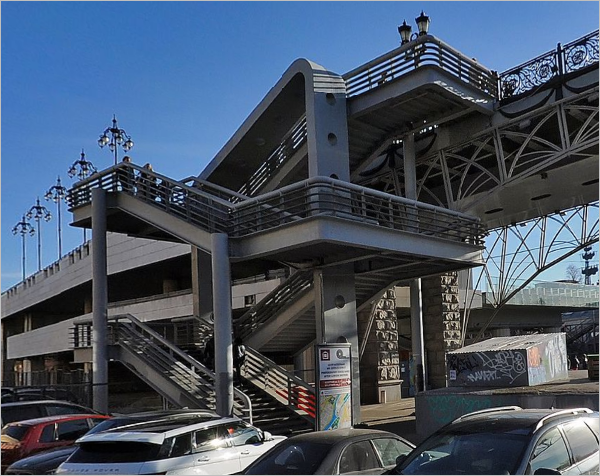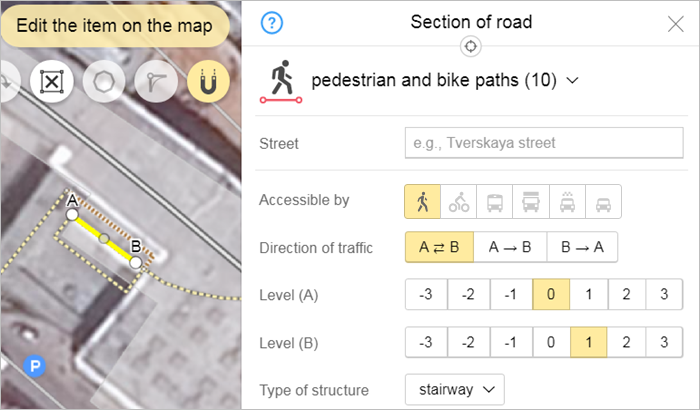3.3.2. Rules for adding attributes to sections of road
- 3.3.2.1. class
- 3.3.2.2. Street
- 3.3.2.3. Accessible to
- 3.3.2.4. Direction of traffic
- 3.3.2.5. Level (A) and Level (B)
- 3.3.2.6. Type of structure
- 3.3.2.7. Design features
- 3.3.2.8. Speed limit
- 3.3.2.9. Pavement
- 3.3.2.10. Oncoming or with-flow public transport lane
- 3.3.2.11. Oncoming or with-flow taxi lane
- 3.3.2.12. Oncoming bicycle lane
- 3.3.2.13. Under construction
- 3.3.2.14. Toll (paid road sign)
- 3.3.2.15. Poor condition
- 3.3.2.16. Residential area
- 3.3.2.1. class
- 3.3.2.1.1. Freeways (class 1)
- 3.3.2.1.2. National motorways (class 2)
- 3.3.2.1.3. Interregional Roads (class 3)
- 3.3.2.1.4. Regional roads (class 4)
- 3.3.2.1.5. District roads (class 5)
- 3.3.2.1.6. Local roads (class 6)
- 3.3.2.1.7. Roads of minimal significance (class 7)
- 3.3.2.1.8. Driveways (class 8)
- 3.3.2.1.9. Field and forest roads (class 9)
- 3.3.2.1.10. Pedestrian and bike paths (class 10)
- 3.3.2.2. Street
- 3.3.2.3. Accessible to
- 3.3.2.4. Direction of traffic
- 3.3.2.5. Level (A) and Level (B)
- 3.3.2.6. Type of structure
- 3.3.2.7. Design features
- 3.3.2.8. Speed limit
- 3.3.2.9. Pavement
- 3.3.2.10. Oncoming or with-flow public transport lane
- 3.3.2.11. Oncoming or with-flow taxi lane
- 3.3.2.12. Oncoming bicycle lane
- 3.3.2.13. Under construction
- 3.3.2.14. Toll (paid road sign)
- 3.3.2.15. Poor condition
- 3.3.2.16. Residential area
The attribute panel for a road section looks like this (shown partially in the drawing):
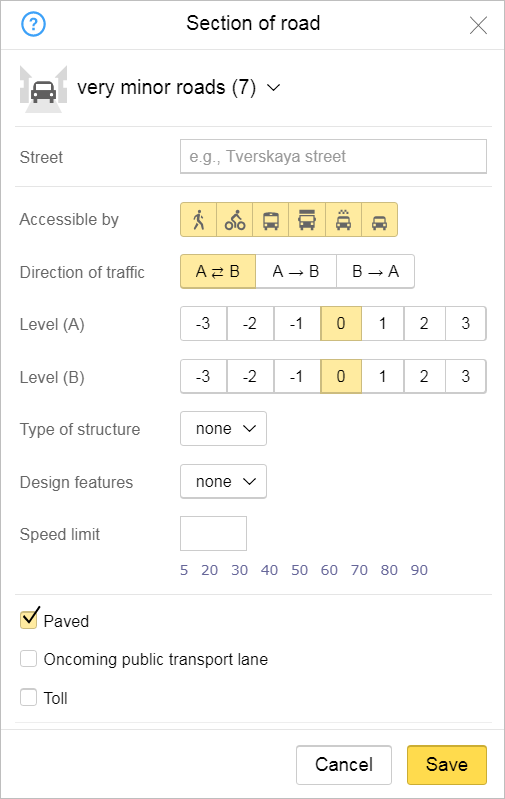
Techniques for adding attributes to road sections are similar to the techniques for adding attributes to all items on YME.
When you add attributes to roads, pay attention to how you assign attributes to road signs that are linked to intersections.
When you add attributes to road sections, follow the rules that apply specifically to them. The Road section item attributes and the rules for setting their values are listed below:
When assigning attributes to a road section or the road as a whole (see Section 3.3.3. Rules for attributing roads), monitor the consistency of set values.
For example, if you enter Tunnel as the Type of structure for a section of road, then the Level A and Level B attributes should have negative values.
3.3.2.1. class
All roads on the national map are classified by their significance in the transportation system: each road element is assigned a specific attribute value Class.
The road class is determined by the types and sizes of localities (and other important features) it connects, as well as by its role in shaping the connectivity of the road network.
To a lesser extent, the road class defines its physical characteristics. However, the fact that a highway has an identification number does not affect its significance.
This means that a narrow single-lane road connecting two cities has a higher class than a two-lane divided road that connects districts within a city.
When you enter a road class, follow the descriptions of each road class given below, as well as these rules:
When selecting a road class, you must preserve how the road is connected to the network: each class of road should connect to roads of higher classes to form a united (connected) network. Also see 3.3.1.1.1.
In particular, keep this point in mind to avoid lowering a road's class in areas where it passes through localities (if there are no roads that circumvent those localities).
Additionally, roads of a particular class should not be connected to the remaining road network exclusively by roads of a lower class. The connection to the network should happen via roads of the same or a higher class.
Valid exceptions:
- Areas isolated from the main road network
- Pedestrian streets (class 7) that have names and end on sidewalks (class 10) — don't artificially extend such streets for the sake of connecting them to roads:
Correct Incorrect 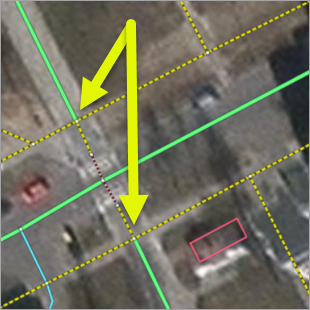
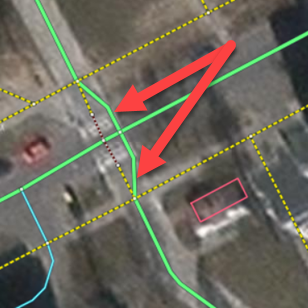
Correct Incorrect 

When there are several roads of the same significance, select the main ones and the ones that are preferable for transit traffic. Assign those ones a higher class. This is particularly necessary in order to avoid assigning the same class to too many roads in city centers.
At intersections and interchanges, the roads and exits that connect roads of different classes are assigned the lowest class even if the exit can serve as a backup of the main highway, except for roads that are only accessible to public transport — such road sections inside intersections and interchanges are always assigned class 7:
- At the exit from a high-class highway to a low-class one, enter the functional class of the lowest class highway for the connecting road or exit. Start from the point where it branches off (i.e. from the beginning of the turn or exit).
- At the entrance from a low-class highway to a high-class one, enter the functional class of the lowest class highway for the connecting road or exit up to the point where they join (i.e. from the beginning of the turn or exit).
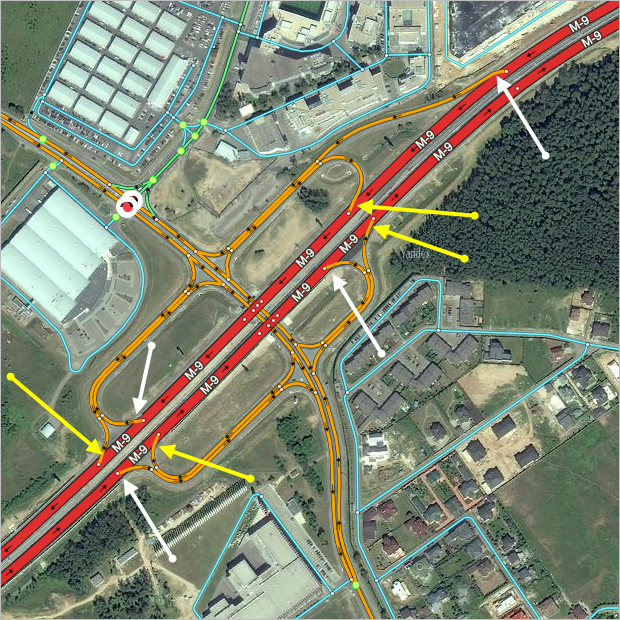
- At the same time, at junctions and intersections of roads of three or more classes, a situation may arise when there are exits that are on the formal the attribute must be assigned to the same class, actually belong to another-this is where they should be assigned when mapping.
- Example 1. The intersection of road #1 (class 2), road #2 (class 5) and road #3 (class 6) is shown in the drawing.
- Exits #4, 5, 6 and 7 connect roads #1 and 2, so based on that formal characteristic and their position in the road network, the exits should be assigned the lowest class from among the classes of connecting roads — class 5.
- Within this same road interchange though, exits #8 and 9 actually connect roads #1 and 3, so the exits should be assigned class 6:
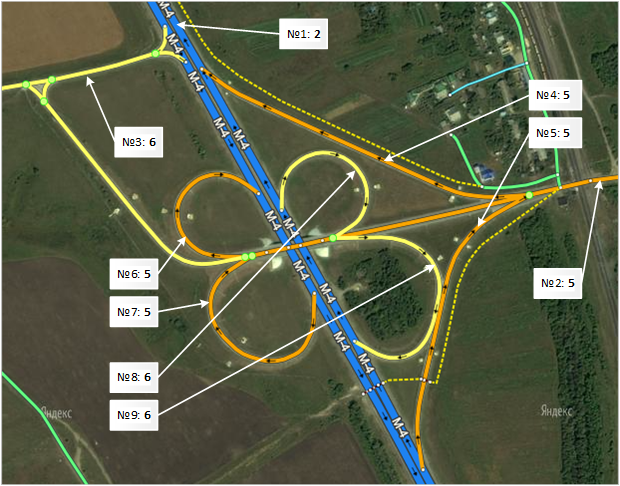
- Example 2. A class-4 road passes through an intersection (purple in the drawing); two other roads cross the intersection: a class-6 road (yellow) and a class-7 road (green).
- Furthermore, the following notes apply to the intersecting parts:
- a) Those marked with red arrows connect class-4 roads
- b) Those marked with blue arrows connect class-6 and class-4 roads (the upper part provides passage from the class-4 road on the left and onto the class-6 road, the right part provides passage from the class-6 road up and onto the class-4 road).
- Therefore, the classes of intersecting road sections should be assigned according to the following rules:
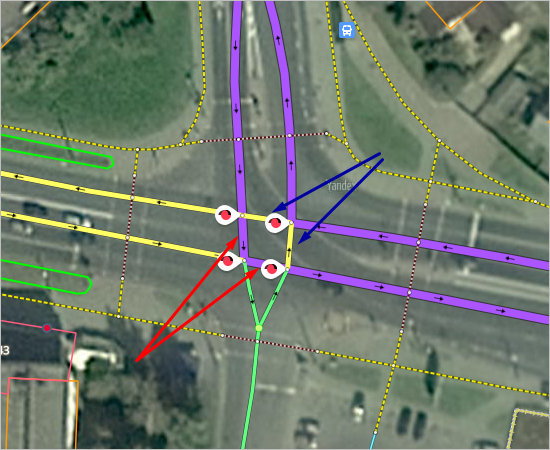
A circular road section will take the same class as the highest class road that intersects with it.
On a road drawn using two lines, any road sections used to make u-turns should have the same class as the road itself:
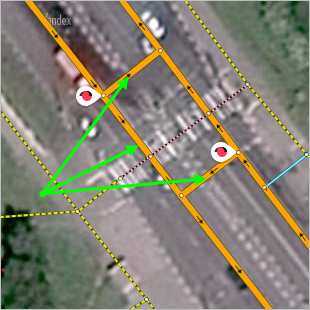
If the u-turn is a continuation of a side road (for example, at a " T " intersection) and is not a u-turn (see 3.3.2.7.6), it gets the class of the side road (see also 3.3.3.4.3. Assigning road sections at intersections):
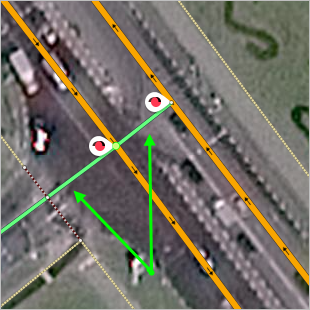
If the u-turn or exit is a continuation of a side road class 8 or Nine, then their class goes up to class 7:
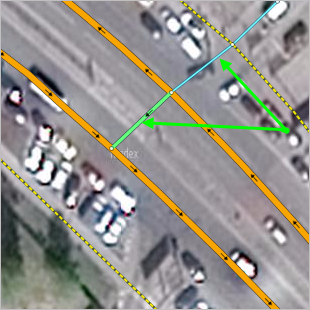
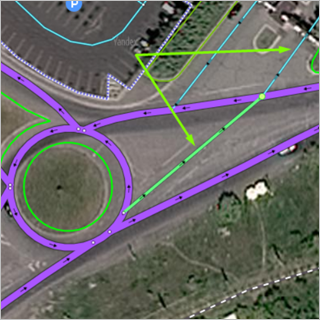


If the intersection of the highest-class road does not change the direction, and the u-bridge is a continuation of the adjacent roads of different classes, its class is set as the highest class of the adjacent roads.:
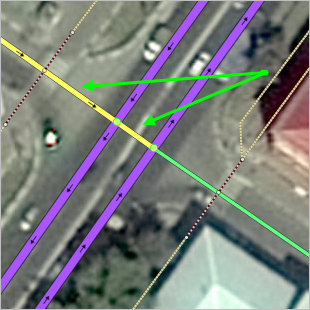
In addition to the road section class, roads in general are characterized by the type of road that is set in the road editing panel (see Section 3.3.3.2. Type of road).
Choose the road class from the list (only a partial list is shown in the drawing):
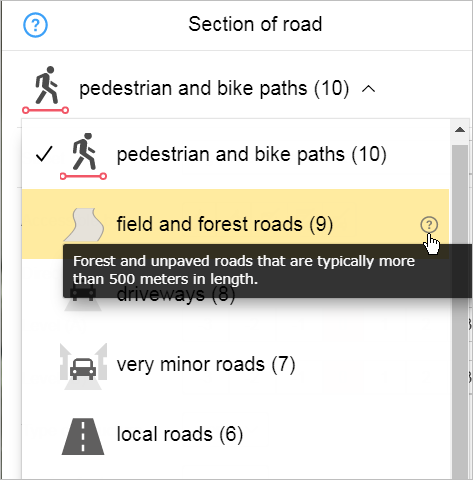
When you hold your cursor over an entry in the list, you'll see a  icon appear on the right side. Hold your cursor over that icon to see a tool tip (i.e. a short description of that road class):
icon appear on the right side. Hold your cursor over that icon to see a tool tip (i.e. a short description of that road class):
A road element class is set according to the rules for selecting attribute values for specific roads:
- 3.3.2.1.1. Freeways (class 1)
-
National highways with the official Freeway status as well as urban highways.
Note.Urban highways are roads in major cities with an increased speed limit (more than 90 km/h), a large number of lanes, and no intersections that allow cars to quickly cover long distances. They are basically the large "rings" around major cities (MKAD, KAD).
Roads of class 1 and 2 complement one another and should form a connected network. For example, the section of highway E-30 in Poland in the area of mińsk Mazowiecki.
- 3.3.2.1.2. National motorways (class 2)
-
Motorways of national and international significance that form the main body of the road network in large and mid-size countries and are the main transit highways in small countries that connect the capitals (or major cities) of neighboring states form class 2.
In large countries, this road network connects the administrative centers of second-level administrative divisions.
- 3.3.2.1.3. Interregional Roads (class 3)
-
Roads of regional and interregional significance form class 3:
Secondary paved highways connecting neighboring countries
Roads leading to major cities from classes 1-2 of the road network
Highways linking neighboring second-level administrative divisions
In major cities and agglomerations, the most significant outbound roads also belong to this class.
In sparsely populated, widespread territories, this level also includes internal roads that are at least 150 km long.
- 3.3.2.1.4. Regional roads (class 4)
-
Key roads of intraregional significance within second-level administrative divisions form class 4:
Main roads that link to each other
Centers of third-level administrative divisions
The largest localities (for that country) that have district centers and either roads of class 1-3 or neighboring districts (if the road in question wasn't assigned a higher class)
In widespread and sparsely populated areas: roads at least 50 km in length that connect 5-10 rural localities along with roads of higher classes or lead to townships with populations of at least 5,000.
In localities with populations over 100,000, outbound highways that are intra-regional and main thoroughfares (other than those that belong to higher classes)
If a road of that class ends in a locality, then it should lead to a central square, vehicle station, or a central intersections.
Within localities, roads of this class may lead to popular transport, social, or cultural attractions of state significance.
Note.The roads are unpaved, leading to administrative centers third-level administrative units, belong to class 4 not follow.
- 3.3.2.1.5. District roads (class 5)
-
Key roads within third-level administrative divisions that were not assigned to a higher class form class 5.
This class includes roads that are not urban and run through several small localities (or lead to one major locality) and connect the latter to roads of class 1-4.
Within localities, roads of this type may lead to extremely popular transport, social, or cultural items of regional significance.
In cities with populations greater than 100,000, class 5 roads include large transit streets that link neighboring parts of a city, and outbound highways that continue past the city as local roads leading to rural localities.
In localities with populations of less than 100,000, class 5 include major transit roads through the city (when there are roads of class 1-4 that circumscribe the city).
If a road of that class ends in a locality, then it should lead to a central square, vehicle station, or a central intersections.
- 3.3.2.1.6. Local roads (class 6)
-
Main local roads
Outside of localities, this class includes roads that are not included in classes 1-5 and that lead to separate localities, rural settlements, and farmers co-ops (or groups of localities that are located in the same area). These roads are not connected to the main road network via roads of a higher class.
In major rural developments (including farmers co-ops and rural (dacha) settlements) this class includes highways and roads that lead to extremely popular transport, social and cultural items of regional significance.
In localities, class 6 roads include main streets that are set off from urban zones (districts, subdistricts or localities that are part of the city), secondary transit streets that are connected to neighboring areas of the city (such as exits from isolated city zones), and frontage roads with no less than three traffic lanes that run adjacent to highways of class 1-4 (see point 3.3.2.7.5).
In small localities, this class is used to represent the main transit road when a road of class 1-5 that circumvents the city is present.
If a road of that class ends in a locality, then it should lead to a central intersections.
Keep in mind that the physical characteristics of roads of this class may notably differ from one another. For example, class 6 includes the the multi-lane Shuvalovsky Avenue in Saint Petersburg:
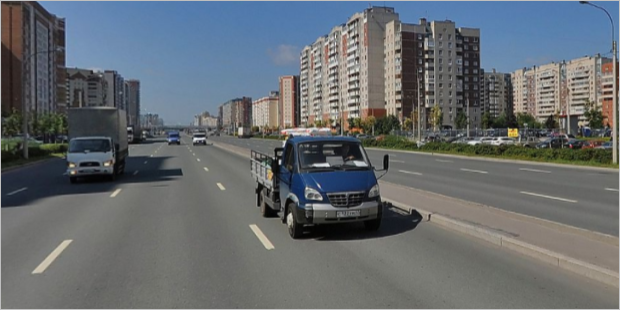
and Tatischeva Street in Yekaterinburg:
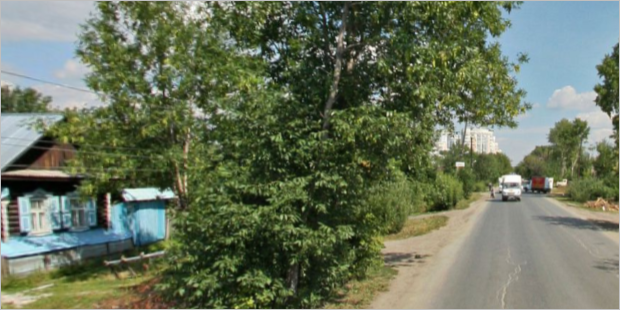
- 3.3.2.1.7. Roads of minimal significance (class 7)
-
This class includes all local roads that have proper names and do not belong to class 1-6 but are technically suitable for motor traffic (even if traffic is prohibited or the street is labeled a pedestrian zone). It also includes intersections between two-line roads.
In rural localities and farming co-ops with unnamed streets, class 7 includes the main road network that has houses located alongside it.
Exceptions to this rule are major roads used to enter, exit, or transit within multistory blocks that cover a large area (including unnamed streets), main roads on major cemetery grounds, and unnamed passageways where cars can move in two or more rows that handle the same traffic as connecting roads.
Class-7 streets are comprised of pedestrian streets (e.g. Arbat St. in Moscow, Bolshaya Pokrovskaya St. in Nizhniy Novgorod, Vana-Posti St. in Tallin). Usually, car entry is prohibited with signs such as “No entry”, “Pedestrian zone”, or “Bicycle lane with shared pedestrian traffic” (“shared lane markings”). These streets should have the accessible to pedestrians and cyclists only attribute.
Note.In rare cases, a “No traffic” sign may be used if such streets are considered pedestrian (pedestrian zones) and only vehicles with special permits have access to them according to local regulations.
This class also includes central alleys and streets in large pedestrian zones (e.g. parks, cultural monuments, sports-related items, and other recreation areas) that make up the backbone of their corresponding road networks and connect the main entries to pedestrian areas. Such roads should be clearly distinguished from the larger pedestrian area network, and must be suitable for specialized vehicles to travel through. Enter the accessible to pedestrians and bicyclists attribute for these roads.
Outside of cities, class 7 roads include paved roads leading to small localities and farming co-ops that are between 1-5 km in length, as well as re-enforced dirt, forest, or field roads (including those that run through shallow riverbeds), and winter roads that are the main or preferred route to a rural locality or a farming co-op.
If a road leads to a locality, it must be at least class 7 regardless of its surface or condition.
Outside of localities, class 7 includes paved roads that lead to transport-related structures and agricultural items, recreational areas, camps for children, local attractions, and networks of technological paved roads within broad industrial areas or territories.
Additionally, this class includes tracks at major car-racing facilities (such as Formula 1 racing tracks).
Class 7 also includes all roads that are under construction or are not going to be put into commission (see section 3.3.2.3.9). The exception are Class 10 roads: pedestrian and bike paths as well as some frontage roads (see section 3.3.2.7.5).
Roads of minimum significance also include dedicated public transport lanes separated from the main road by a physical divider.
- 3.3.2.1.8. Driveways (class 8)
-
Roads that are only used to get to one concrete place (the entrance of a building, a particular tourist attraction, etc.) and are not used to transit anywhere form class 8:
- 1) Un-named paths and dead ends on the territory of individual developments
- 2) Passageways within courtyards or blocks
- 3) Roads to small industrial zones and roads on closed territories within industrial zones, organizations and institutions such as hospitals, hotels, resorts, recreation and wellness centers, etc.
- 4) Exit ramps going from highways to gas stations or parking lots, roads on the territories of gas stations and parking lots
- 5) Branches from main unnamed passageways and roads in individual development areas (including farming co-ops)
- 6) Internal passageways on the territories of garage complexes
- 7) Tracks at medium and small race car, go cart, and motorcycle racing complexes.
- 8) service and technical exits from major highways and freeways (including “free” entrances and exits from toll roads not intended for car transit):
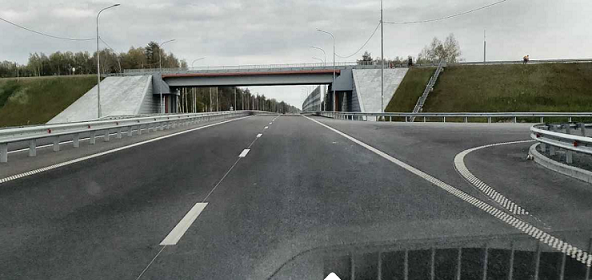

This class is typically found in localities. If they are found outside of localities, it is generally only in the cases described in points 3 and 4.
Roads of this class must have their availability parameter set for cars (except for race tracks that should have all their values disabled).
Note. Only unofficial streets can pass through sections of Class 8 roads. Assigning an unofficial name to a road is not sufficient reason to upgrade the class of its sections. - 3.3.2.1.9. Field and forest roads (class 9)
-
Forest and field unpaved roads (not received a higher class).
- 3.3.2.1.10. Pedestrian and bike paths (class 10)
-
This class comprises roads that can not physically support vehicles (or traffic laws prohibit vehicle passage on them).
This includes sidewalks; pedestrian roads through parks or cemeteries, within building blocks (including paths to entrances from intra-block driveways), or over railways or motorways; staircases, pedestrian bridges and tunnels, and named streets that cannot be physically traversed by vehicle (if, for example, they are narrow paved or asphalt paths).
Additionally, this class includes trails at major ski reports, running tracks at stadiums and sports complexes, and equipped ski trails at ski and biathlon stadiums.
For this class of roads, always disable accessibility to cars and trucks.
Use the “Pedestrian crosswalks” and Design features attributes for Pedestrian crosswalks.
Assign named streets where traffic is prohibited (such as Arbat Street in Moscow) to class 7 rather than class 10 (see Section 3.3.2.1.7).
Also see also Color-coding by road type.
3.3.2.2. Street
The panel Street field is used to specify the name of the street (road), which includes the shaded area. The name shows what road the section belongs to.
- A map or a resolution of the administration of the organization (allowed to be displayed on the map) that named the road.
- An address that belongs to this street and is allowed to be displayed on the map.
Don't fill in this field for class 9 roads.
When you enter the characters that make up the road (street) name in the field, a list of roads (streets) that are already drawn on the map and that have the characters entered in the name field is opened for selection:
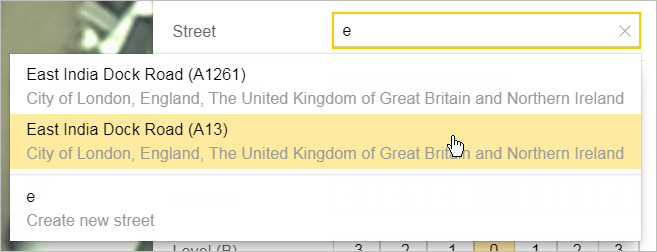
When you fill in the field, keep in mind that streets often partially overlap with each other, so a specific section of road may simultaneously belong to several roads with different names. For example, Begovaya St. in Moscow is also part of the Third Transport Circle.
In these cases, you can add the appropriate number of attribute values after you enter the first value.

When you fill in the field:
If the street is already on the map, then select its name from the list of suggestions.
If the street is not on the map, you must fill in this field manually: enter a name for the new road and it will be created. When naming roads, follow the rules for naming roads (see Section 3.3.3.3. Road name).
After the item is saved, its name will appear as a link in the attribute panel:
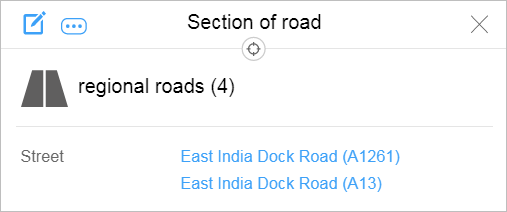
Clicking this link opens the panel for viewing and editing road attributes, including its composition (for more information, see Section 3.3.3. Rules for attributing roads).
3.3.2.3. Accessible to
In the field “Available for” sets the accessibility of the road element for vehicles (vehicles) and pedestrians. The attribute value is determined by whether it is possible to travel on a road element on different types of vehicles (TS), or to walk on it. Whether a vehicle can be used for transportation or not is decided based on driving regulations and traffic signs rather than a vehicle's actual capacity to drive through a location. There are exceptions to this rule, such as: accessibility of public transit and bicycles as well as accessibility of isolated road networks in hard-to-reach settlements.
Currently you can't edit accessibility for cargo trucks or create turns that apply only to trucks.
The available values convey whether the road is accessible to pedestrians, bicyclists, public transport, taxis, trucks, and/or light vehicles.
Click the appropriate button to enter this attribute (click once to indicate that a given section of road is accessible to pedestrians, bicyclists, public transport, trucks, light vehicles, or taxi, and click again to indicate that it is inaccessible to that group). An icon shows whether the attribute is enabled or not. The button becomes semitransparent when the attribute is disabled:
 →
→ 
When entering attribute values:
- 3.3.2.3.1
-
Only use the “Pedestrian” attribute for crossings (provided other options are not regulated by the traffic rules of the country where the crossing is located).
- 3.3.2.3.2
-
For roadways:
- 3.3.2.3.3
-
The “Bicycle” value is used forroad sections adult cyclists can drive through in accordance with traffic rules.
As an exception, the “Bicycle” value is enabled in situations where Signs 3.1 (“Entry prohibited”) or 3.2 (“No traffic”) are set to prohibit the passage of cars and trucks in both directions and do not actually prohibit the passage of cyclists. This is often the case in park driveways.
The “Bicycle” value is not used at T-junctions on road sections if they are located between a sidewalk and roads that are not accessible to cyclists.- For example, in picture a) the value is set to “Bicycle”, and in picture b) that value is off:
- а)
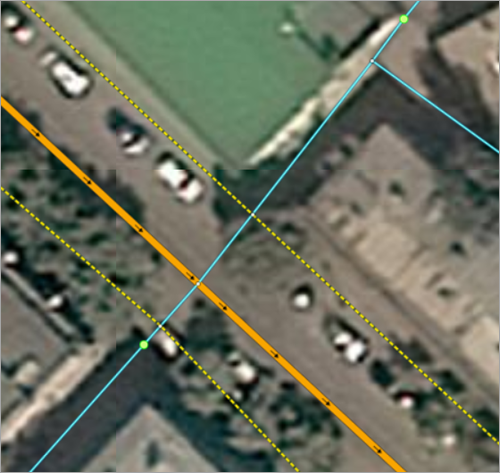
- b)
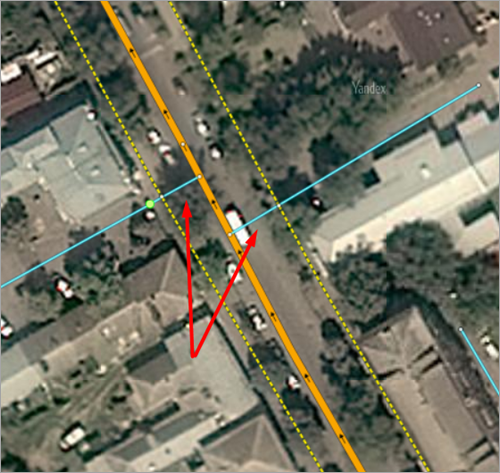
Whether road network sections located between the lines of a road drawn with two lines are accessible to bicycles:
- No, if the traffic regulations prohibit bicycles from using these sections.
- Yes, if the traffic regulations allow bicycles to use these sections.
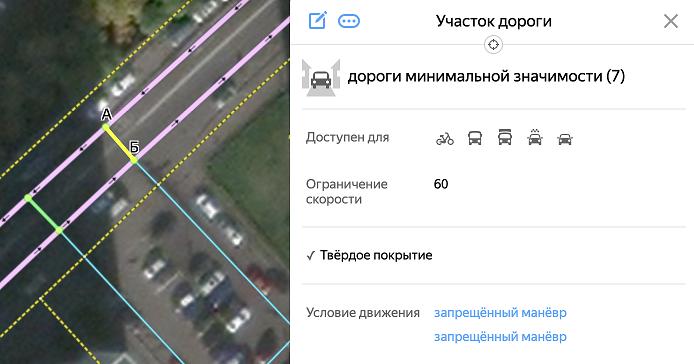
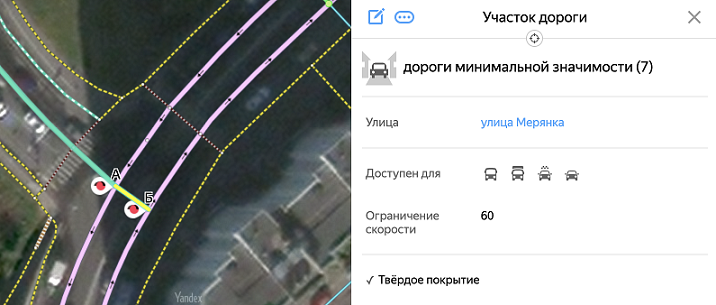
Do not disable the Bicycle value for sidewalks that run along an intra-block driveway.
However, the “Bicycle” value is disabled for class-9 and class-10 roads in cases where the route is impossible or very difficult to travel through on a bicycle.
Also turn off the “Bicycle” value for temporarily closed highway sections or if the design features of the road network won't change if the road is closed.
Sections of Class 10 roads connecting sidewalks and pedestrian crossings are considered sidewalks and attributed accordingly.
Attention.The rules for setting accessibility values for sections of road that bicyclists can use may differ by country (in accordance with local traffic laws).
- 3.3.2.3.3.1
- For dedicated bike paths (see section 3.3.1.6.5. Bike paths) only the “Bicycle” attribute value is used.
Furthermore, don't mark bike paths that run parallel to vehicle or pedestrians roads as accessible, except for cases when the entire sidewalk along the highway is given over to the bike path and pedestrians do not have alternative roads nearby. In such cases, the bike path is marked as accessible to both bicycles and pedestrians.
Note. These rules apply:- For one-way bike paths — to the nearest sidewalk and the edge of the strictly one-way road the bike path runs along.
- for two-way bike paths — to the nearest and opposite sidewalks as well as the nearest road (if it is a two-lane road, the rule applies to both lanes).
- 3.3.2.3.3.2
-
If an underground or aboveground pedestrian crosswalk or stairway has a ramp accessible to bicycles, use this attribute value.
With that said, ramps not separated from the main road by a physical divider are not drawn as a separate track.
If the ramp is physically separated from the track or stairs, then drawing it is preferable but not required:
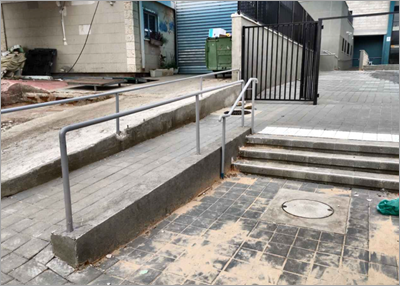 Note.
Note.If the stairs are part of a sidewalk without bike access, bike accessibility for stairs should also be disabled.
- 3.3.2.3.4
-
Use the “Public transport” value for all roads of class 1-7.
Attention.Accessibility for public transport (FROM) on the roads of classes 1-7 can be removed in exceptional cases when this is necessary for the correct operation of the route threads from.
Only users with expert rights in the “Transport” layer can remove or edit public transport accessibility (see 3.14.3. Rules for creating public transport route options and adding attributes to them).
Don't use“ the ”Public transport value for any roads of class 8-10 except for sections that are used for public transport routes (such as traffic circles at ending stops).
Also “don't use” the Public transport value for any of the roads indicated under point 3.3.2.3.6.
- 3.3.2.3.5
-
If the only road leading inside an area is closed off with a “No entry” sign and access is permitted only to emergency vehicles, this road should be marked as accessible only to pedestrians and bicycles.
- 3.3.2.3.6
-
For ski trails, running paths, and similar items, use the “Pedestrian” value exclusively.
For go-kart, motorbike, and other racing tracks, disable all attribute values.
- 3.3.2.3.7
-
Use the “Taxi” value for all roads of class 1-9 where traffic laws allow taxi traffic.
If taxi entry to the territory is prohibited by the administration (the Restricted entry sign isn't installed), disable taxi accessibility for all entrances to the territory.
Note.When setting the accessibility attribute, keep in mind that taxis are not public transport moving along a permanent route.
- 3.3.2.3.8
-
If a road in a settlement is completely disconnected from the main road network, transport accessibility should be determined in the following way:
- The general rules for transport accessibility apply if a car can be driven/taken to a settlement in one of the following ways:
by railway (a railway station where a car can be loaded and unloaded should be located near the settlement)
by water (one must draw a ferry crossing between the settlement and the locality connected to the road network, even if the ferry crossing doesn't have a regular schedule or it's unknown)
by air (the settlement must be located near an airport, airdrome, or a helicopter landing zone which can deliver vehicles to the location)
- by ice crossing or winter road (one must draw an ice crossing or winter road between the settlement and the locality connected to the road network)
- If a settlement can't be reached by any of these methods, then the settlement roads are only considered accessible for pedestrians and cyclists).
- 3.3.2.3.9
-
All constructed roads that are unaccessible and not put into service should receive the Class 7 status and all transport and pedestrian access to them must be disabled.
3.3.2.4. Direction of traffic
Click the button to enter the appropriate traffic direction in the “Direction of traffic” field for each road section (pay attention to the rendering direction between the beginning A and ending B points):

А ⇆ Б — traffic goes in both directions (from А to B and B to A)
А → Б — traffic goes from A to B only
A ← B — traffic goes from B to A only
The "Direction of traffic" attribute is set according to the traffic regulations.
For class-8 roads, one-way traffic can be set on the basis of both signs and the actual traffic on site. For example:
- A boom gate that allows only entrance to or exit from the territory.
- A 3.1 No entry road sign on site (it is enough to set one-way traffic on the section between road intersections that this sign applies to).
If a two-way road is temporarily rearranged for one-way traffic due to construction or repairs, don't change the traffic in the affected road sections. Please use error reports to notify us if one of the traffic directions becomes inaccessible (specify the repair timeframe if possible).
Enter the “Traffic allowed in both directions” value for pedestrian and bike paths.
You can indicate that traffic goes one-way on pedestrian paths in the following situations:
Athletic tracks where traffic is set to move permanently in one direction year-round (such as on ski paths, bike tracks, etc.).
Entrances and exits to the most popular cultural, social, and transport-related map items where the entrances and exits are clearly demarcated for traffic going in one direction, such as at the Moscow Kremlin.
3.3.2.5. Level (A) and Level (B)
Enter values for the road level in the Level A and Level B fields:

- 0 (ground level) — if sections of road that intersect are both on ground level. For example, at intersections or railway crossings.
- 1, 2, 3 — above ground level. For example, if one road at an intersection passes over another on a bridge or as part of an interchange and the second road or railway is at ground level.
- -1, -2, -3 — below ground level. For example, if one road at an intersection passes through a tunnel and the second road is at ground level.
Values “Level And” and “Level B” must be filled in for each road section.
If the intersecting roads intersect on the same level, at the intersection point, the road elements must have the same level values. If roads intersect in the plan but are located at different heights, these road elements must have different levels at the intersection (in the plan).
For a road that consists of multiple sections, each section should be logically connected with the others using the correct “Level A” and “Level B” values (see Examples of setting road levels).
The majority of road sections have a zero value for “Level A” and “Level B”.
- 3.3.2.5.1
-
You can only change the values of road levels (including pedestrian paths) if they pass through tunnels, underground parking structures, or over bridges (see point 3.3.1.1.6.1).
If the road follows a stylobate or the local terrain and rises along with a slope or falls along with a valley, this does not affect the value of the road level.
- 3.3.2.5.2
-
Road sections can not have values for Level A and Level B that differ by more than one. If there is a difference of 2 or more, there is an error in the allocation of the road element and it must be divided into two (or more) sections.
To make sure the road network is connected, set the level values for pedestrian roads inside a building joined by an elevator or a staircase that don't differ by more than 1.
- 3.3.2.5.3
-
Descents and ascents into and out of above/below ground pedestrian crosswalks are marked using levels (similarly to how different types of road sections are marked).
- 3.3.2.5.4
-
Sections of road that have the “Bridge” attribute can not have values for the beginning and ending points of less than “+1”, even if there is no visible rise in the road level (for example, if the bridge passes over a small river):
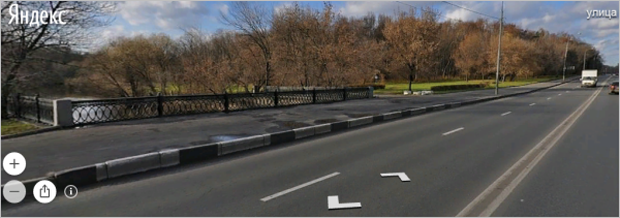
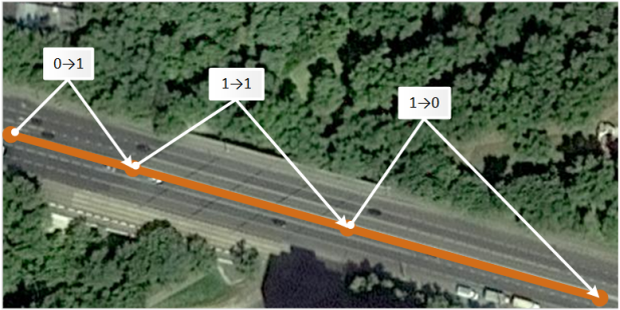
- 3.3.2.5.5
-
The sections of road that approach a bridge or tunnel and have non-zero values for levels A and B should not be longer than the length of the bridge or tunnel.
If a section of road that is the same length as the bridge or tunnel doesn't include a single intersection with other roads, then you must create an additional point on the road in order to lower its level.
For example, in the drawing on the left, the approaching road section 0→1 is substantially longer than the bridge itself (1→1). Therefore, you should create an additional point on this level and split the section (into sections 0→0 and 0→1) so that the length of the approaching road (0→1) is the same as that of the bridge (1→1) in the drawing on the right:
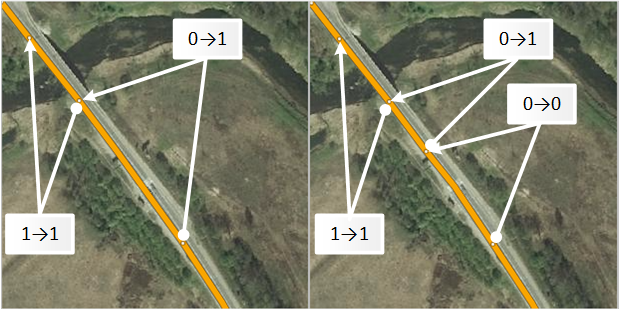
- 3.3.2.5.6. Examples of setting road levels
-
The drawings below are simple examples of how to set levels:
а) At intersections of a vehicle bridge passing over a river:
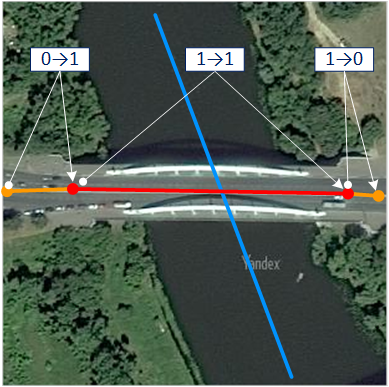
b) At intersections of a vehicle bridge passing over another motorway:
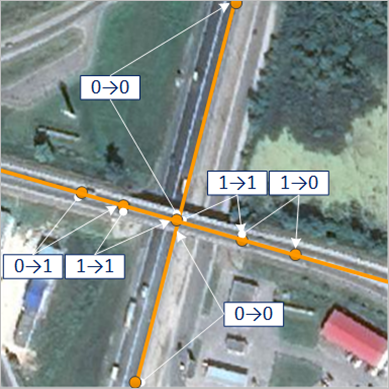
с) At intersections of motorways passing through a tunnel with another motorway:
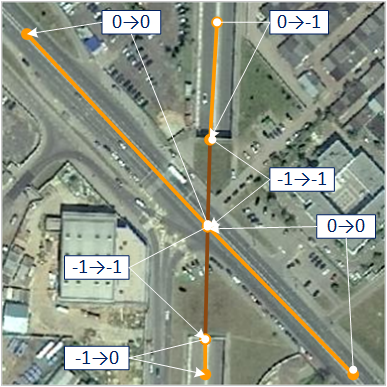
d) Examples of setting road levels at interchanges are given in Section Examples of how to set road levels at interchanges.
It is necessary to strictly observe the connectivity of the routing graph (see para. Connectivity): attribute value “Level And” and “Level B” they should be changed not only for sections of roads in a tunnel or on a bridge, but also for sections adjacent to them. Otherwise the road graph will be disconnected.
For logical breaks in the road graph (as a result of incorrectly set levels), it is not possible to construct a route that passes through the section of the gap.
3.3.2.6. Type of structure
The “Type of structure” attribute doesn't characterize the road structure itself (that's what the Road infrastructure item category is for), but rather that section of road (including pedestrian roads) that run through that structure (i.e. the bridge, tunnel, etc.).:
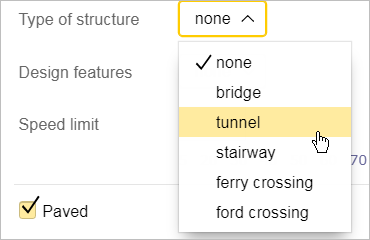
The roads passing over bridges on the national map include the roads that are located on bridges (underpasses, overpasses) across rivers, roads, ravines, or other physical obstacles. For information on bridge boundaries, see point 3.8.1.1.3.
If the roadbed has a transitional level (for example, 0,1 or 0,-1), the start and end points of the roadway sections with transitional levels should be connected to the roadbed boundary.
When you select the “tunnel” type, you must pay attention to the tunnel features that lets you figure out if the situation you are mapping is a “bridge over a road or a tunnel under a road”:
- Roadbed:
- or routed through a natural or artificial elevation (rock formations or road embankment),
- Or (in developed areas and/or in interchanges) the road level continuously lowers in relation to the ground level until it reaches the entrance portal to a tunnel.
- The presence of entrance or exit portals: these are considered to be the boundaries between the tunnel and the section of road with the “tunnel” attribute.
When entering attribute values:
- 3.3.2.6.1
-
Draw the part of road that runs through the structure as a separate section of road (regardless of whether the road is drawn using one or two lines).
Enter the beginning and ending points for these road sections at the points of entry and exit to the road structure: the points where the bridge connects to the ground (don't include the embankment part of the bridge) and the portals to the tunnel.
In the image, the red lines indicate the correct bridge boundaries and the yellow lines show them incorrectly:
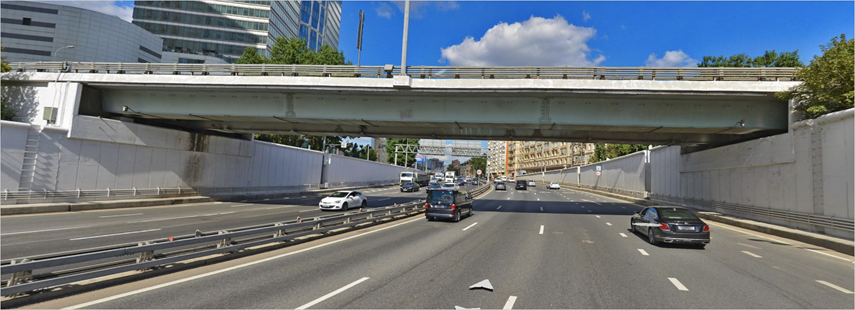
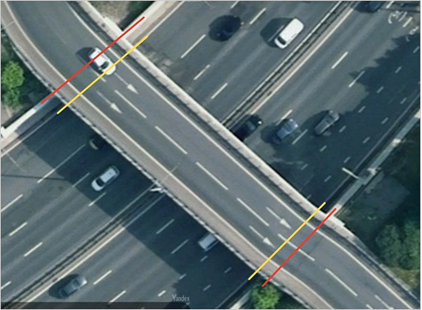
- 3.3.2.6.2
-
Underground and aboveground pedestrian crosswalks are marked with attribute values.
- 3.3.2.6.3
-
You “should not mark” a value for the “Bridge” and Tunnel attributes (i.e. “there aren't any” attribute values) for the following:
Road structures that consist of pipes and dirt embankments that water flows through beneath the road.
Parts of the road that run under arches in residential buildings.
- Sections of road that pass through underground parking lots.
- 3.3.2.6.4
-
Assign the "Stairs" value to the attribute whenever the road section is stairs.
Note. Exceptions apply when the road section with stairs should not be drawn on the map as per the Rules. For example, if such a section of a road is a sidewalk along a driveway, and it is not drawn as a separate edge, the stairs are also not drawn. - 3.3.2.6.5
-
The "Ford" value is assigned to an attribute on road elements that intersect a small area in a river or stream (which can be reached on foot or by car).
A road section's class must be the same as all the adjacent road sections. Disable the paved attribute and enable the disrepair attribute.
3.3.2.7. Design features
You can select an attribute value from the drop-down list. Possible values:
- 3.3.2.7.1. None
-
For road sections that don't have any of the design features listed below (i.e. they consist of one roadway, etc.) Default value.
- 3.3.2.7.2. Two roadways
- For road sections, which are drawn in two arcs in accordance with the rules, see Section 3.3.1.2. Rules for drawing roads in one/two arcs (one or two lines).
- 3.3.2.7.3. Circular traffic
-
For road sections that form a circle (ring), which must be confirmed by a “Roundabout” road sign or set of similar signs (depending on the country):
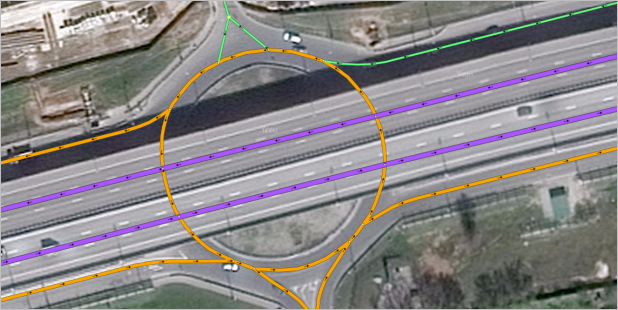
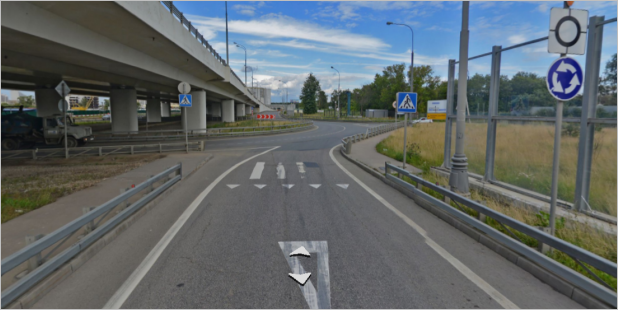
- 3.3.2.7.4. Exit
-
Road sections intended for unloading traffic flows and ensuring the connectivity of the road graph.
At single-level interchanges: one-way road sections that have no travel variations (traffic from that section only moves in one direction).
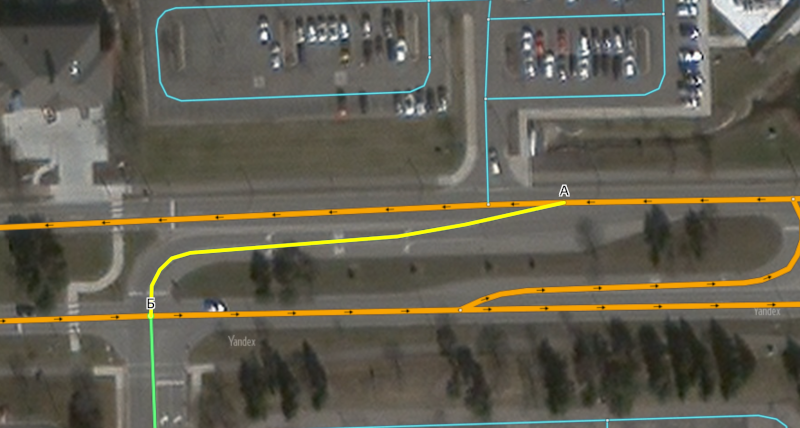
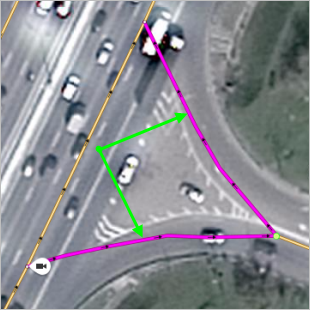
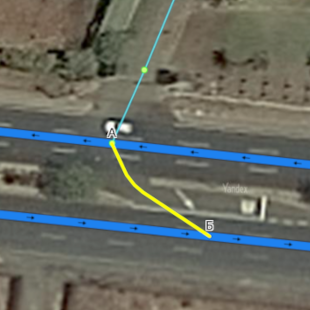
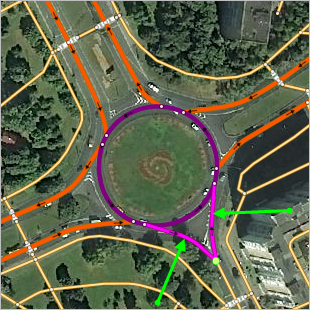
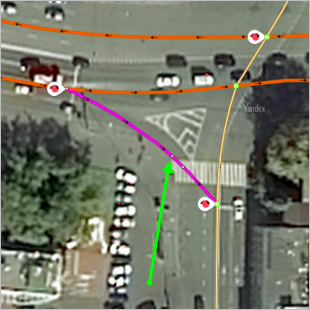




At multi-level interchanges: road sections used primarily to exit a road of one level and enter a road of another level:
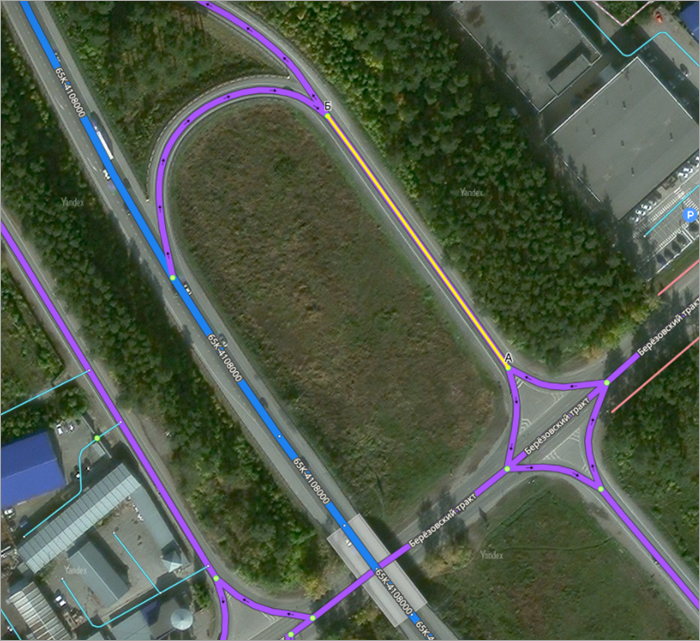
Road sections that are parallel to the main road and separated from it by:
a dividing line:
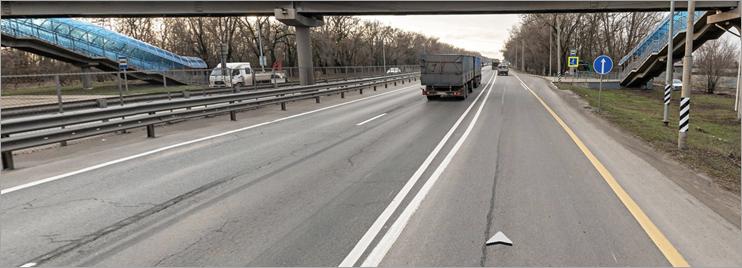
a bus lane:

Note.Assign the Exit attribute to lanes used for parking cars or as driveways to yards provided they're marked as a "traffic island":
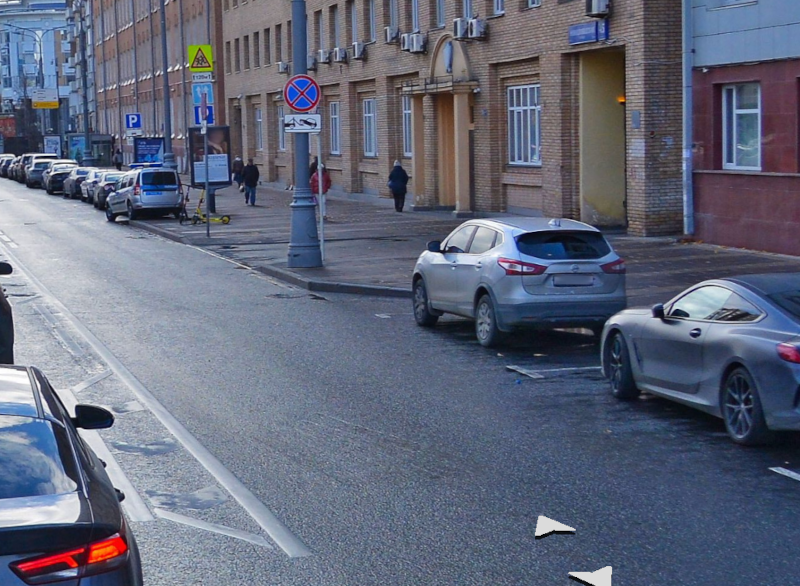
- 3.3.2.7.5. Frontage road
-
Sections of Class 1-7 road making up a frontage road that meets the following conditions:
- Begins and ends on the same road.
- Runs parallel to the main road for at least a part of a block and up to several kilometers and is separated from this road by a physical obstacle.
- Continuously runs along a major street for several blocks.
- Intersects with other road sections without creating any curves that the main road doesn't feature.
Frontage roads are designed to reduce the traffic flow on the main road and intersections with other roads and driveways:
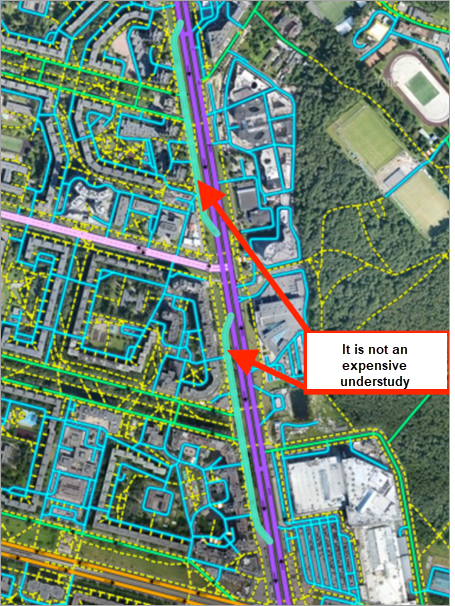
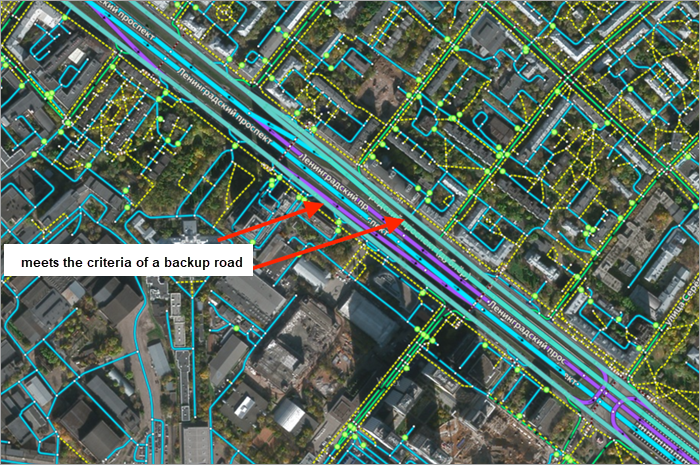 Note. If the road that meets the listed criteria has a proper name in the format “Exit ...”, it is attributed as an exit ramp, not as a frontage road.
Note. If the road that meets the listed criteria has a proper name in the format “Exit ...”, it is attributed as an exit ramp, not as a frontage road.Frontage roads can't have a higher class than the main road:
Assign Class 6 to frontage roads that are at least three lanes wide and run parallel to Class 1-4 roads as well as to frontage roads that are 1-2 lanes wide and connect Class 1-6 roads with Class 6 roads.
Assign Class 7 to frontage roads that are 1-2 lanes wide and run parallel to 1-7 class roads.
- 3.3.2.7.6. U-turn
-
Only set this attribute for sections of roads if there are signs and markings that permit U-turns. For example:
 ─ U-turn allowed or
─ U-turn allowed or ─ U-turn area
─ U-turn area
Furthermore, that section of road should not be a continuation of a road of class 1-7.
Note.If the area doesn't have road signs of the “U-turn allowed or U-turn area” types, the U-turn value of the Design features attribute is only assigned to road sections that are intended solely for turning and only allow traffic in the opposite direction.
- 3.3.2.7.7. Pedestrian Crosswalk
-
Specially equipped road sections intended as road crossings for pedestrians (and cyclists, if permitted by traffic regulations) and marked with signs or markings: underground, ground-level, and aboveground crossings (including descents and ascents).
These areas are assigned a class value of10. Pedestrian paths.
If a cyclist doesn't have to dismount when passing a bicycle crossing, then it doesn't need the “pedestrian crossing” attribute.
When mapping underground and aboveground crossings, keep in mind that they are not only drawn as road sections, but also as Road infrastructure items.
- 3.3.2.7.8. Access overpass
- This attribute should be set for road sections with the structure type of a “bridge” when passengers board or exit at this section of the road to reach important locations, such as airports or shopping malls.
3.3.2.8. Speed limit
Enter the speed limit attribute for that section (in km/h or m/hr).
If speed is measured in miles per hour in the country you are mapping, then enter that attribute value in miles per hour (not kilometers per hour).
You can enter typical speed limits by clicking on the appropriate value below the field (5, ..., 90). If the value you are looking for is not there, you can enter it using your keyboard.
Do not enter a speed limit for field roads (class 9) or pedestrian and biking paths (class 10).
If the speed limit is only in effect during nights, don't enter it.
The speed limit should be a multiple of 5. If you try to enter an invalid speed limit, you will get an error warning. To save the road section, you must fix the error:

When you create a new section of road, the attribute value will be entered automatically. If a different speed limit is in effect on that road section, then you should correct the default value.
If a two-way road section has different speed limits for different directions, enter the speed limit for the direction A→B in the Speed limit field, and the speed limit for the direction B→A in the Speed limit B→A field:
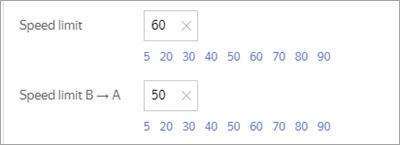
Do not enter a speed limit for the direction B→A:
- For one-way road sections.
- For two-way road sections where the speed limit is the same in both directions.
The default attribute values are listed in the table (Localities — locality, Class — attribute 3.3.2.1. class).
If a road section partially crosses the border of a locality (but also exits the border of that territory), then assign that section the lesser of the speed limits in effect on the territory it occupies.
| Country | Class 1 | Classes 2-7 (Localities) | Classes 2-7 (Outside localities) | Class 8 |
|---|---|---|---|---|
| Russia | 110 | 60 | 90 | 20 |
| Ukraine | 130 | 50 | 90 | 20 |
| Belarus | 120 | 60 | 90 | 20 |
| Kazakhstan | 140 | 60 | 100 | 20 |
| Abkhazia | 110 | 60 | 90 | 20 |
| Georgia | 110 | 60 | 90 | 20 |
| South Ossetia | 110 | 60 | 90 | 20 |
| Azerbaijan | 110 | 60 | 90 | 20 |
| Moldova | 50 | 90 | 20 | |
| Turkmenistan | 110 | 60 | 90 | 20 |
| Tajikistan | 110 | 60 | 90 | 20 |
| Uzbekistan | 70 | 100 | 20 | |
| Kyrgyzstan | 110 | 60 | 90 | 10 |
| Armenia | 110 | 60 | 90 | 20 |
| Latvia | 50 | 90 | 20 | |
| Estonia | 50 | 90 | 20 | |
| France | 130 | 50 | 90 | 50 |
| Turkey | 120 | 50 | 90 | 50 |
| Lithuania | 130 | 50 | 90 | 50 |
| Latvia | 110 from March 1 to December 1 90 from December 1 to March 1 | 50 | 90 | 20 |
| Country | Class 1 | Classes 2-7 (Localities) | Classes 2-7 (Outside localities) | Class 8 |
|---|---|---|---|---|
| Russia | 110 | 60 | 90 | 20 |
| Ukraine | 130 | 50 | 90 | 20 |
| Belarus | 120 | 60 | 90 | 20 |
| Kazakhstan | 140 | 60 | 100 | 20 |
| Abkhazia | 110 | 60 | 90 | 20 |
| Georgia | 110 | 60 | 90 | 20 |
| South Ossetia | 110 | 60 | 90 | 20 |
| Azerbaijan | 110 | 60 | 90 | 20 |
| Moldova | 50 | 90 | 20 | |
| Turkmenistan | 110 | 60 | 90 | 20 |
| Tajikistan | 110 | 60 | 90 | 20 |
| Uzbekistan | 70 | 100 | 20 | |
| Kyrgyzstan | 110 | 60 | 90 | 10 |
| Armenia | 110 | 60 | 90 | 20 |
| Latvia | 50 | 90 | 20 | |
| Estonia | 50 | 90 | 20 | |
| France | 130 | 50 | 90 | 50 |
| Turkey | 120 | 50 | 90 | 50 |
| Lithuania | 130 | 50 | 90 | 50 |
| Latvia | 110 from March 1 to December 1 90 from December 1 to March 1 | 50 | 90 | 20 |
Also see also Road color-coding by speed limit.
- 3.3.2.8.1
-
You can enter this attribute for any section of road (other than pedestrian and bike paths), on which a speed limit is in effect (whether it applies to that locality or is specific to that highway) or corresponding traffic signs are present:
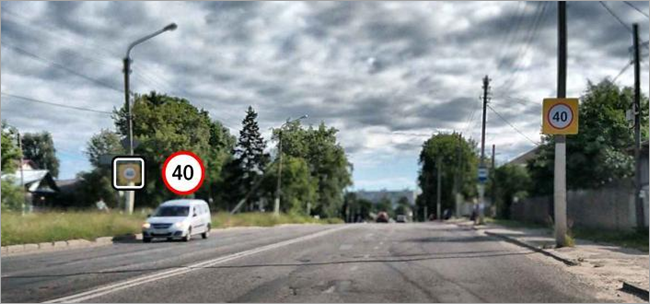 Note.
Note.The locations of road signs for the Beginning and Ending of a locality (and the points where the speed limit changes) often do not coincide with the administrative borders of a localities.
- 3.3.2.8.2. Temporary speed limit signs
-
Temporary speed limit signs have a yellow background inside the information contour of the sign (in contrast to the yellow reflective frame around the information contour in permanent signs):
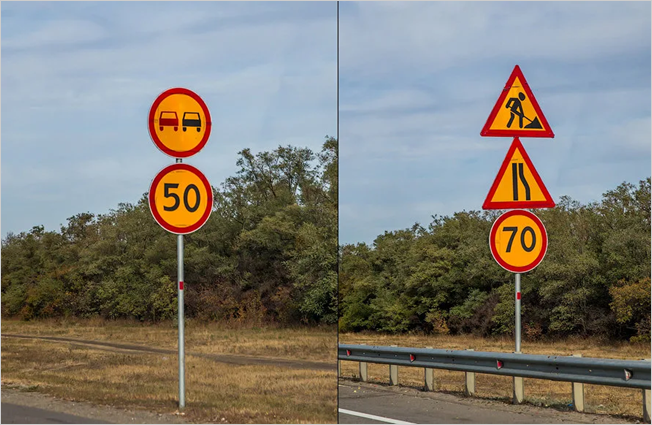
Speed limit signs that are accompanied by a sign about construction on this section of the road are also considered temporary signs:
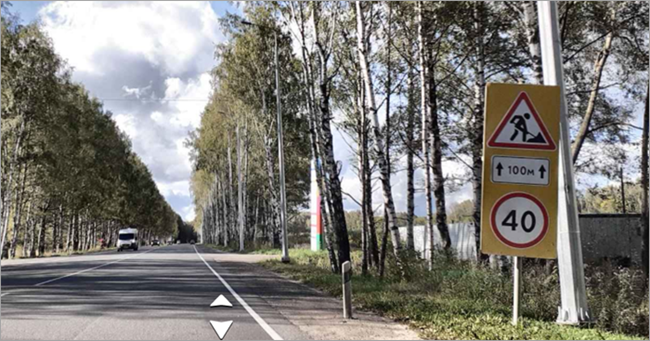
Only set speed limit values for temporary signs if they've been installed in one location for more than half a year due to road construction or repairs.
For other temporary speed limits (due to repairs, road or weather conditions, etc.), the attribute value should be set based on permanent signs and/or traffic regulations.
- 3.3.2.8.3
-
If the speed limit for a road section differs by time of day, enter the daytime value for the attribute.
- 3.3.2.8.4
-
If a single-lane road section has different speed limits in different passing lanes, the attribute is set to a value that applies to more lanes. If the number of lanes with different speed limits is equal, the lowest restriction is set.
- Exception: when the restriction applies to a branch of the main road, but the sign is set before the actual turn.
- For example, if the sign is placed on the lane leading to an overpass:

- the restriction is placed directly at the turn:
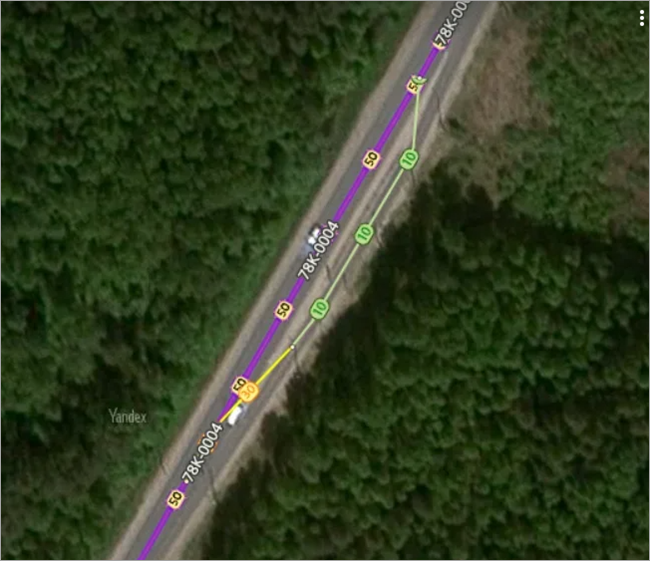
If a road section has differing speed limits for different modes of transport, the attribute is set to a value that applies to passenger cars.
- 3.3.2.8.5
-
If after passing a speed limit sign before one or more artificial bumps (“speed bumps”), the speed limit isn't canceled by a 3.25 “End of the maximum speed limit zone” sign, a 3.31 “End of all restrictions zone” sign, or a speed limit sign with a different maximum value, set the speed as follows:
- For one artificial bump in the middle of a block: in accordance with the sign on both sides of the bump at a distance of about 10 meters from it.
- For two artificial bumps restricting a pedestrian crossing: in accordance with the sign, from the sign in front of the first bump to the sign installed in front of the second bump in the opposite direction (if there are no other signs restricting the speed between the bumps).
- For an artificial bump in front of an intersection: before the intersection in the direction of the intersection and at a distance of about 20 meters from the bump in the direction away from the intersection.
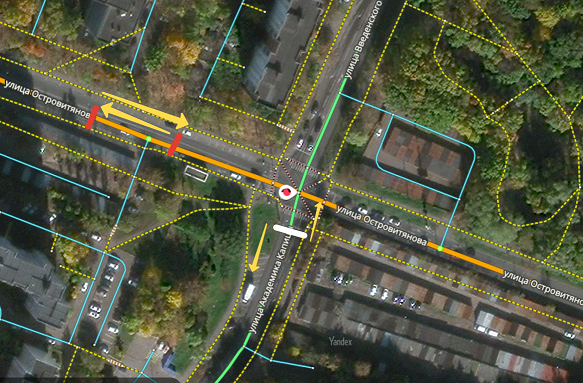
3.3.2.9. Pavement
Flip the “Paved” switch on if a road section is paved using asphalt, concrete or paving stones (such as on Barrikadnaya St. in Moscow).
Wooden covering, gravel, or crushed stone are not considered pavement, except for pedestrian paths (for them, any cover of any material is considered pavement).
For paved roads, set the value to “Yes” (check the box): For all other types of road, set the value to “No” (don't check the box):
For ferry crossings, the attribute's value should be set to “Yes” (checkbox selected).
You can remove the Paved switch for sections of roads where scheduled repairs or roadway improvements are carried out to include the removal of pavement for a period of more than two months.
Also set the "No" attribute value for polluted road sections where it's impossible to determine whether they are paved. However, don't set the "Poor condition" attribute for them.

3.3.2.10. Oncoming or with-flow public transport lane
These attributes are set for road sections with oncoming or with-flow public transport lanes.
Set the value to “Yes” (check the box) for road sections that are parts of these type of roads. For all other road sections, you can set the value to “No” (don't check the box):
The “Oncoming lane for public transport” attribute indicates that there's a traffic lane specifically allocated for public transport going in the opposite direction (on one-way streets).
You can only set the value to “Yes” for one-way road sections (see 3.3.2.4. Direction of traffic) without a dividing line.
The With-flow bus lane attribute indicates that there is a traffic lane specifically allocated for public transport going in the same direction (only for one-way road sections).
Public transport lanes are marked with road signs and markings:
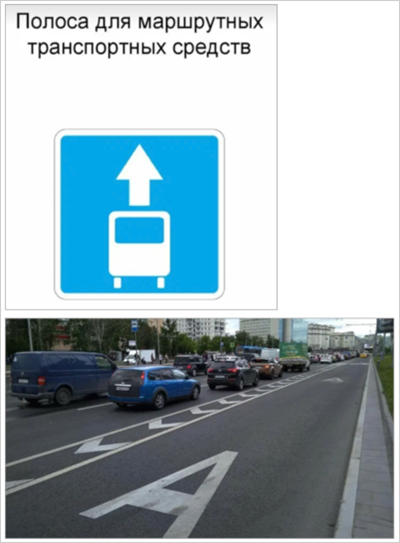
If a public transport lane ends immediately before the intersection and continues immediately after it, set the attribute without any gaps in the network (this also applies to intersections with intra-block driveways).
Examples:
Although the public transport lane breaks at the entrance to the yard, the attribute is set without breaks:
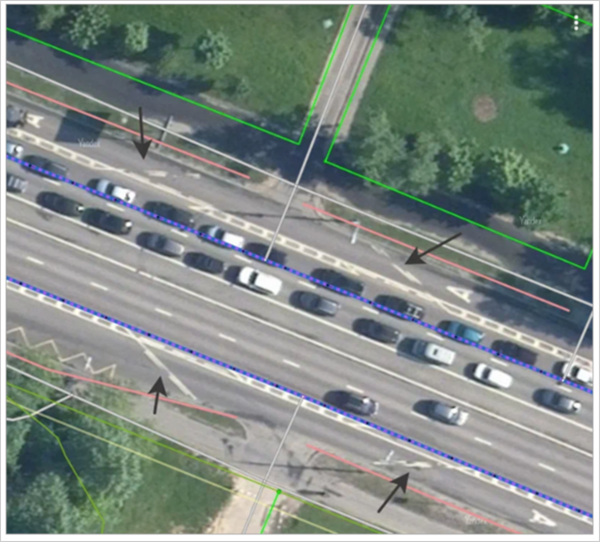
The public transport lane ends at the stop line and continues immediately after the intersection, so you do not need to exclude the selected sections:
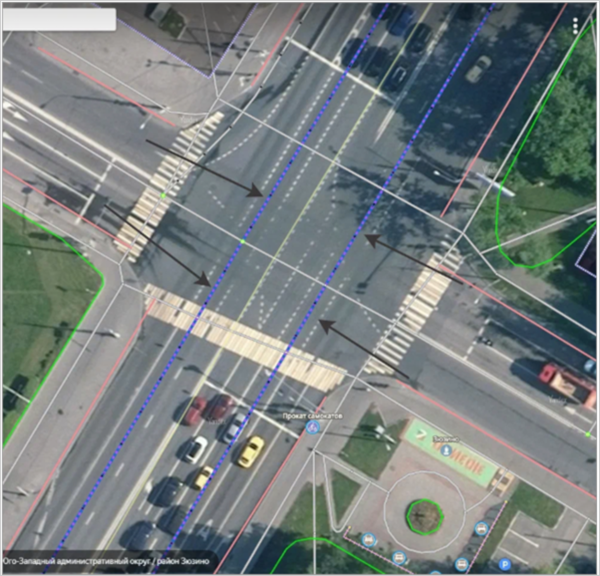
In this case, do not set the attribute for this section, as the public transport lane ends before the intersection, but continues after the roundabout:
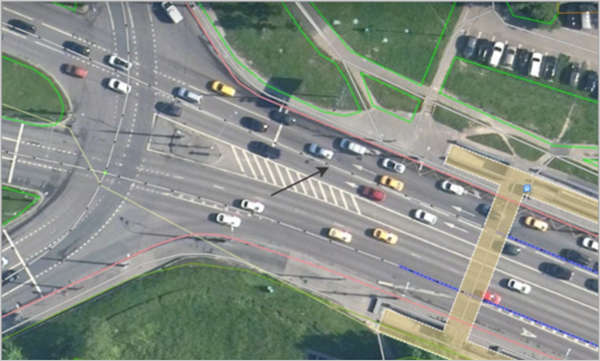
3.3.2.11. Oncoming or with-flow taxi lane
The “Oncoming lane for taxi” attribute indicates that taxi can drive through a traffic lane specifically allocated for public transport going in the opposite direction (on one-way streets), if there is such a lane.
Only set this attribute for one-way road sections (see 3.3.2.4. Direction of traffic) that don't have a dividing line.
If the public transport lane on a road section is closed by the “No entry” sign, do not check the box, since only public transport is allowed under this sign. For example:
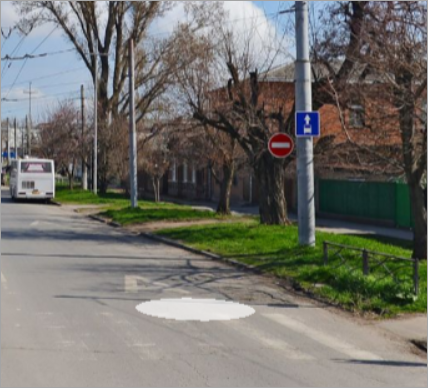
The With-flow taxi lane attribute indicates that taxis can drive on traffic lanes specifically allocated for public transport going in the same direction (on one-way streets) if there is one.
Taxis can drive on traffic lanes specifically allocated for public transport at all times except when the sign for lanes specifically allocated for public transport is accompanied by a 3.1 “No entry” sign:
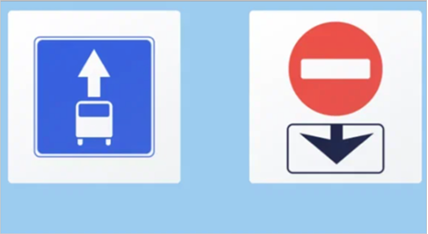
Set the value of the corresponding attribute to “Yes” for road sections that have oncoming or with-flow taxi lanes (choose the option).
For all other road sections, set the value to “No” (don't choose the option).
3.3.2.12. Oncoming bicycle lane
The “Oncoming bicycle lane” switch enables bicyclists:
- To travel along traffic lanes allocated for public transport going in the opposite direction (on one-way roads) where there is such a lane
- To travel against traffic on one-way roads following road signs and traffic regulations even in the absence of a dedicated lane
Set the value to “Yes” (check the box) for road sections that are parts of these type of roads. For all other road sections, you can set the value to “No” (don't check the box):
You can only set the value to “Yes” for one-way road sections (see 3.3.2.4. Direction of traffic).
3.3.2.13. Under construction
The “Under construction” switch lets you show that a road section is under construction.
For paved roads, set the value to “Yes” (check the box). For all other road sections, you can set the value to “No” (don't check the box):
When setting the value to “Yes” for this attribute, you should also set it to “Unavailable” for all modes of transport (see the description of attribute 3.3.2.3. Accessible to).
Roads undergoing construction and repairs should have the \"Under construction\" attribute in the following cases:- For pedestrian roads — if traffic is being restricted for more than two months.
- For roads — if road construction takes more than three months and results in changed design features (for example, a road with no design features receives the “two-way road” attribute).
Please use error reports to notify us if one of the traffic directions becomes inaccessible or if pedestrian traffic gets restricted for a short while (specify the road repair timeframe if possible).
You can draw “under construction” sections of the road when the following steps are being made in preparing the site for construction: engineering and geological research, clearing and excavation, demolition, transmission line transposition, materials and equipment dispatch.
In rare cases, Yandex may revoke the \"Under construction\" status beforehand if a road section is having its official opening soon.
If a planned street already has addresses even though there are no buildings on it or sections that are under construction, you can draw the planned location of the road sections that are “under construction”.
When drawing roads under construction, follow the rules for connecting the road network. If a class 6 road (or higher) is undergoing construction or repairs, you must raise the class of the roads used as a detour so that no breaks in the network of high-class roads occur. Lower the class of roads that temporarily become less significant due to construction or repairs.
If assigning the “Under construction” attribute to road sections isolates adjacent sections from the road network, you need to:
- Assign the “Under construction” attribute to dead-end road sections of class 8 or higher and set their class to 7
- Disable accessibility for vehicles for road sections of class 9 or 10.
Roads under construction display using dotted lines on the map:
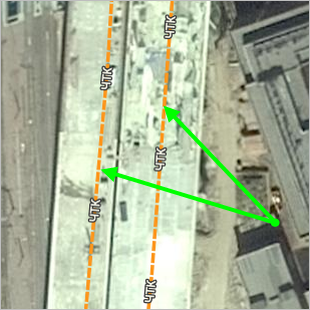
All roads under construction (except for class 10 roads) are class 7. Class 10 roads under construction (pedestrian) will still be class 10 (see also point 3.3.2.1.7).
The rules for naming roads that are under construction are similar to the naming rules for all roads (see Section3.3.3.1. Rules for naming roads).
3.3.2.14. Toll (paid road sign)
The “Toll” attribute marks sections of road that you must pay to use.
For sections of toll roads, set the value to “Yes” (check the box). For all other road sections, you can set the value to “No” (don't check the box).
Set the “Yes” value of the attribute for all road sections where tolls are collected according to official documentation (such as the M-3 road sections between km 124 and km 173) as well as road sections that only exit onto toll road sections (separate isolated sections are not included in the toll road).
You “do not need” to enter the Yes value:
For u-turns on paid sections or roads of class 8
For road sections that function as exits to paid parking lots (such as at airports).
For road sections that are disconnected from the toll road network and create gaps in it:
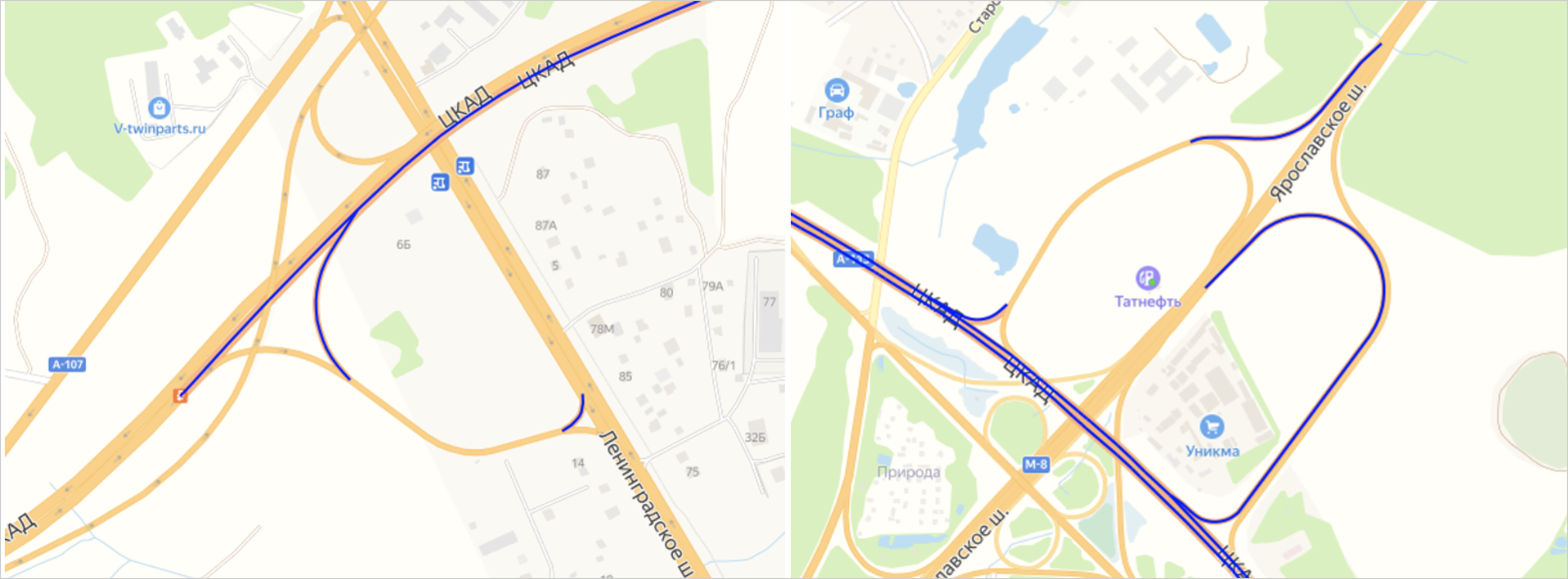
3.3.2.15. Poor condition
The “Poor condition” switch lets you show that a road section is in unsatisfactory condition.
This attribute must also be enabled for all road sections with the Ford “structure type”.
For paved roads, set the value to “Yes” (check the box). For all other road sections, you can set the value to “No” (don't check the box):
This attribute is only set for class 1-9 roads.
Only enter this value in accordance with these rules:
- If the “No” value is set for a road section to indicate that it's not paved, then only set the “Yes” value for the “Poor condition” option in cases where it's not possible to drive through that section in a passenger car in dry weather.
- If the “Yes” value is set for a road section to indicate that it's paved, then only set the “Yes” value for the “Poor condition” option if there are potholes that you can't drive around. If a road is made of concrete slabs, then set this value if large openings have formed between the blocks or if the blocks themselves have been destroyed, potholes have formed, and the reinforcement bars are exposed.
You can only change the attribute value when the poor/good condition of the road surface changes:
- On a section of class 1-7 or 9 road no less than 200 meters or one block in length
- On a section of class 8 road which either is bordered on both sides by intersections with at least 3 motorway sections accessible to cars, or is bordered on one side by a similar intersection and by a dead-end intersection on the other side (attribute change doesn't mean creating new intersections of road graph sections)
- Example 1:
-
The arrows in the picture indicate road sections in disrepair. Areas with blue arrows can have their “Poor condition” attribute value set to “Yes”, while those with red arrows can't.
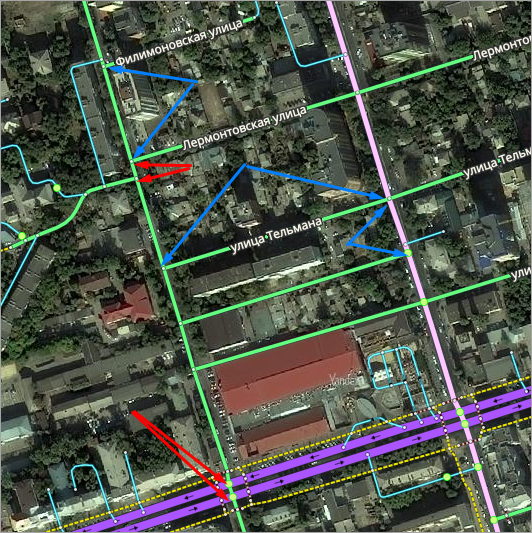
- Example 2
-
The pictures show sections of class 8 roads that are in poor enough condition that they can have their “Poor condition” attribute value set to “Yes”.
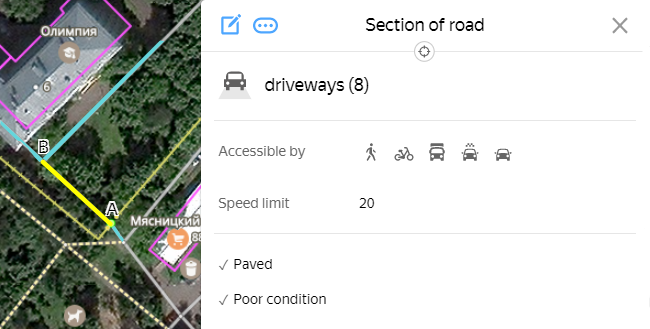
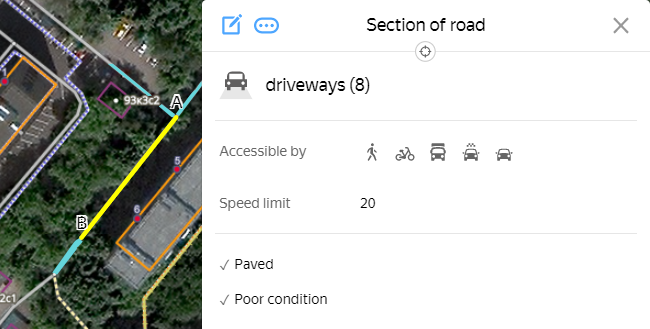
Below are images of roads marked with the “Poor condition” attribute in Yandex Map Editor.
Road in poor condition made of cement slabs:
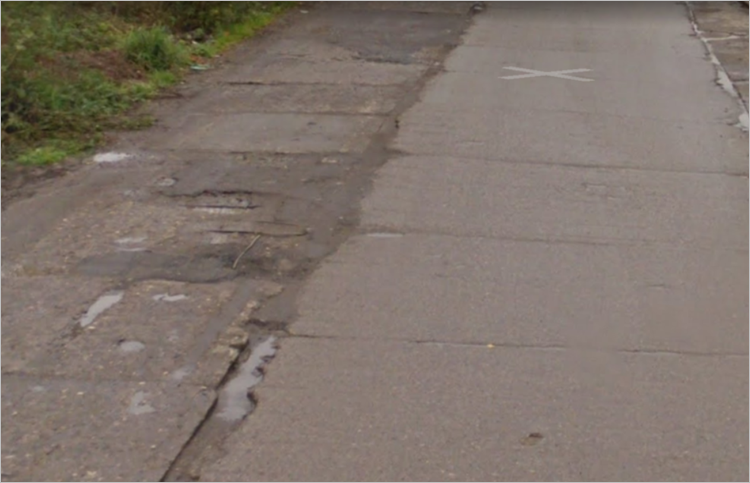
Road in poor condition made of cement slabs:
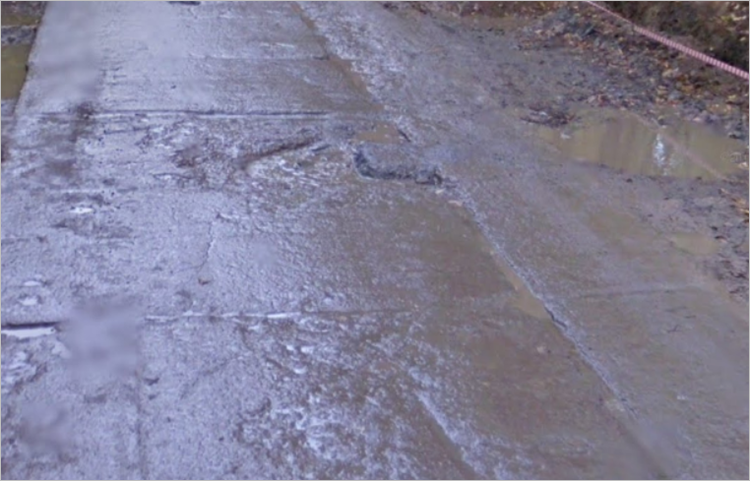
Paved road in poor condition:
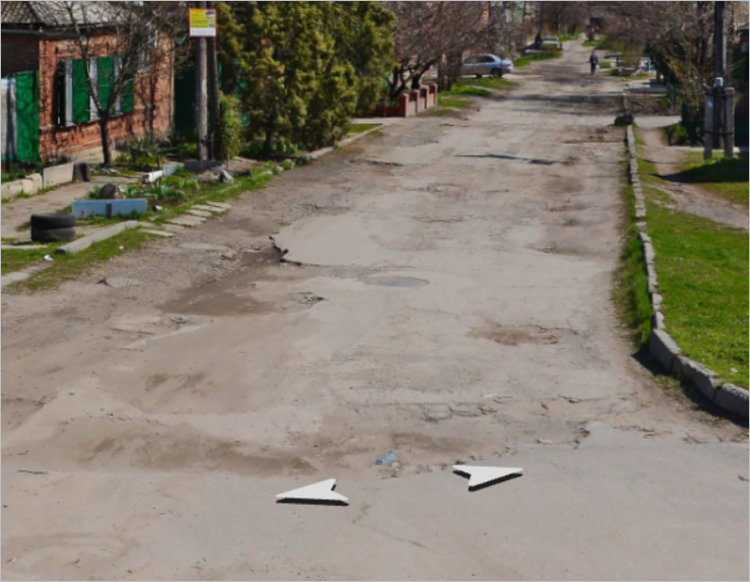
Paved road in poor condition:
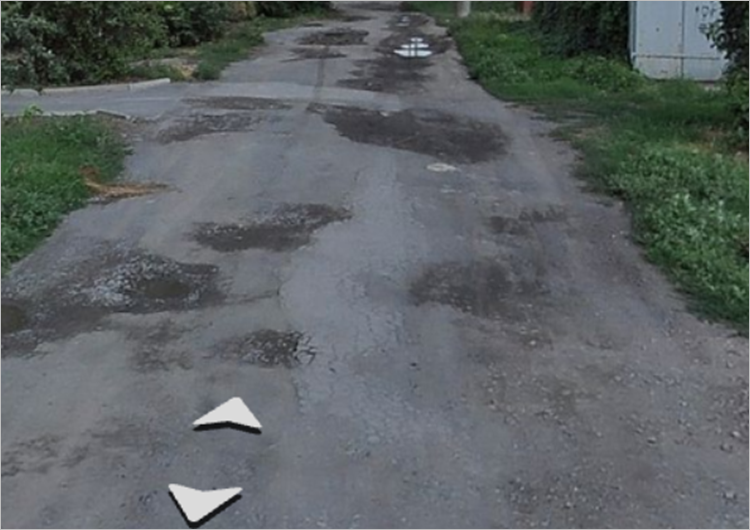
Unpaved road in poor condition:
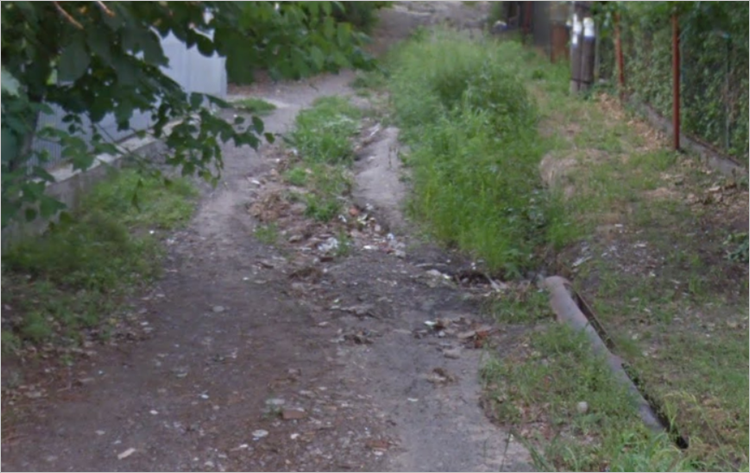
Unpaved road in poor condition:
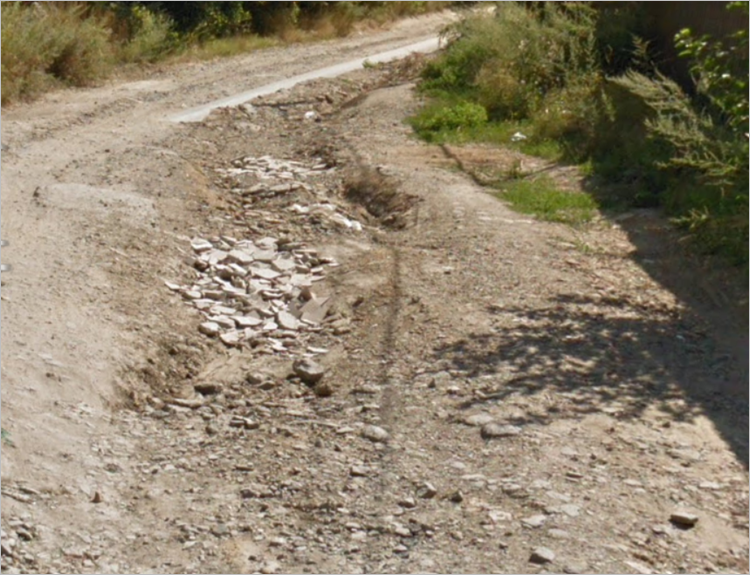
3.3.2.16. Residential area
The “Residential area” toggle sets a limit for traffic in given a road section.
Its value should be set to “Yes” (the toggle is on) for road sections of class 6 and class 7 when the traffic is restricted by a “No traffic”, “No motor transport”, or “Residential area” sign, as well as for road sections in areas restricted by a “No entry”“” sign with an extra description indicating that the road is intended for private access:

Additionally:
If all or some entrances through class 1-7 roads are restricted by signs (“No traffic”, “No motor transport” or “Residential area”) or any combinations of those signs with boom barriers, then the value of all class 6 and 7 roads inside the area should be set to “Yes”.
For instance, if some entrances to a real estate area (indicated by red arrows) are restricted by “Residential area” signs, then the attribute value for all class 6 and 7 road sections inside the area (indicated by an outline) should be set to “Yes”:
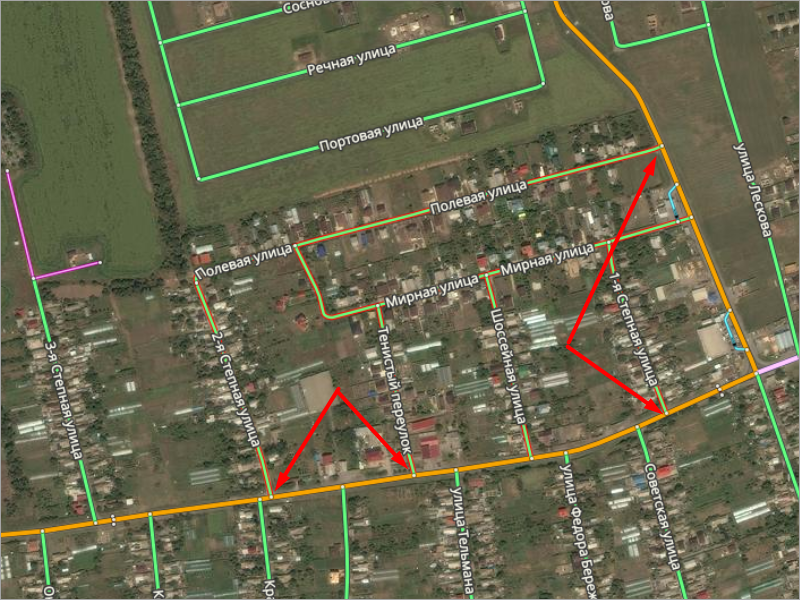
If a class 6 or class 7 road:
- Has a “Residential area” sign installed, mark it with the “Residential area” attribute up to the “End of residential area” sign.
- Has “No traffic” or “No motor vehicles” signs on both sides of the block, mark it with the “Residential area” attribute within this block.
Exception: if access to a class 6–7 public road (which has no “Residential area” attribute because of other signs) is restricted with a “No traffic” or “No motor vehicles” sign in one lane while the other lane is open, don't set the “Residential area” attribute. Instead, place a restricted entry sign near the sign at the nearest intersection. Also see also 3.3.4. Road conditions.
For example, if part of the road is blocked off with “Residential area” signs (indicated by red arrows), then all class 7 road areas receive the “Yes” value to its attribute: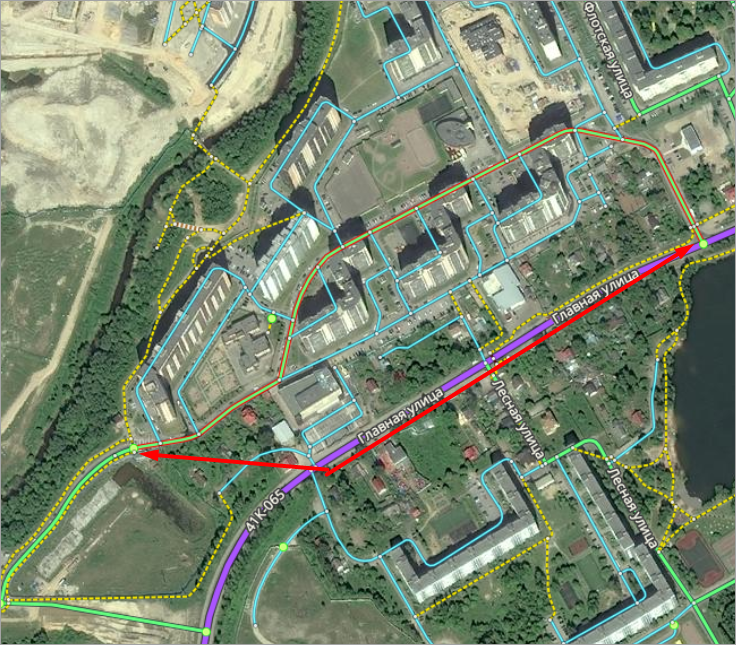
- If a class 6 or class 7 road has a “Residential area” sign installed, but no “End of residential area” sign and it's also impossible to determine which area the sign relates to, don't assign the “Yes” value to its attribute.
For example, if a sign is installed in an area indicated by the arrow, and there are no more “Residential area” or “End of residential area” signs, don't set the attribute value to “Yes”:
